Chess Notes
Edward Winter
When contacting us by e-mail, correspondents are asked to include their name and full postal address and, when providing information, to quote exact book and magazine sources. The word ‘chess’ needs to appear in the subject-line or in the message itself.
| First column | << previous | Archives [120] | next >> | Current column |
8701. Elo ratings
A question from Stuart Rachels (Tuscaloosa, AL, USA): what are the best sources of information about Elo ratings, including such matters as whether a given master ever reached the top ten?
We have many, but not all, of the booklets International Rating List brought out twice yearly by FIDE. To mention just the edition of exactly 20 years ago, the 203-page tome was sponsored by IBM and published by the FIDE General Secretariat in Athens:
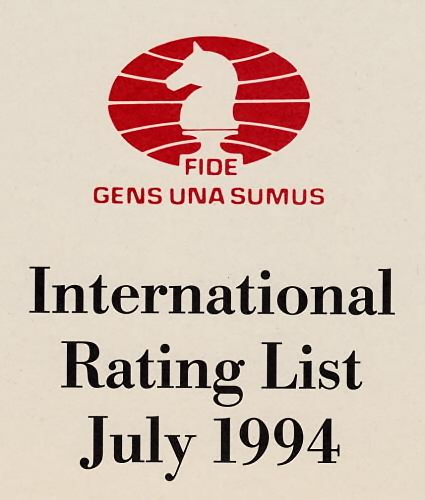
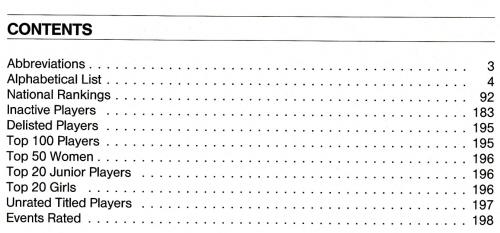
Have bibliographical details for the full run ever been prepared?
Also sought are the best (most accurate and comprehensive) on-line resources. The OlimpBase website has a ‘History of Elo ratings 1971-2001’ which allows searches for individual players, as does FIDE’s Ratings page.
8702. The Pillsbury attack (C.N. 8699)
Alan McGowan (Waterloo, Canada) notes that the game in C.N. 8699 was published on pages 151-152 of the 5 July 1939 issue of Schach-Echo. The heading:
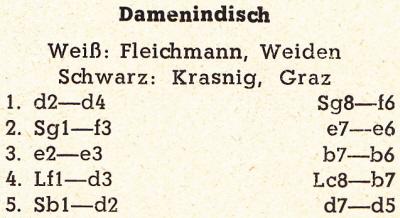
No venue was specified, so it remains unclear why Chernev put ‘Bochum’. He spelled the players’ names as in Schach-Echo (Fleichmann and Krasnig). The German magazine identified them as coming from, respectively, Weiden and Graz, which corresponds to the information given in the Carlsbad, 1939 crosstable (C.N. 8699), as well as on page 135 of the May 1939 Deutsche Schachzeitung (also concerning Carlsbad, 1939). However, both those items used the spellings Fleischmann and Kraßnig. A further complication is that the annual index of Schach-Echo had Fleischmann and Krasnig for the game in question (which was not published in either Deutsche Schachzeitung or Deutsche Schachblätter).
Can the game be found in any chess columns of the time?
8703. FIDE presidential campaigns (C.N. 8690)
A new feature article, FIDE Presidential Campaigns, includes a selection of items in our archives from the 2006 campaign, in which Kirsan Ilyumzhinov was challenged by Bessel Kok:
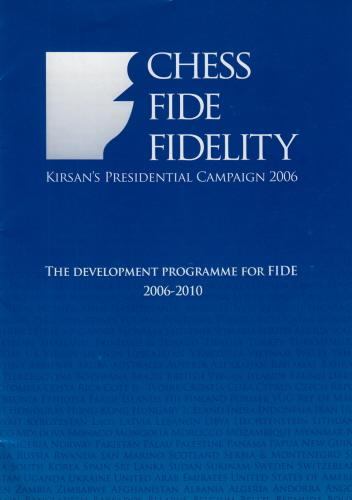
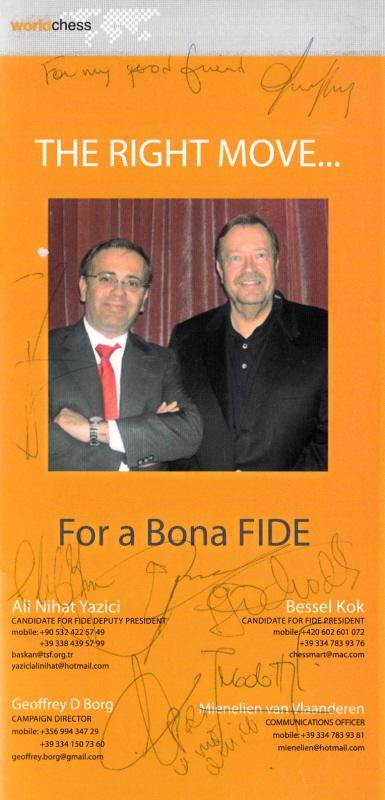
8704. Bernstein v Mieses, Coburg, 1904
From page 160 of The Most Instructive Games of Chess Ever Played by Irving Chernev (New York, 1965):
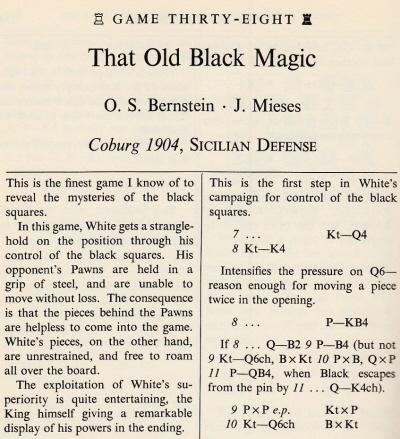
In his annotations to the game (pages 160-165) Chernev did not indicate explicitly which move or moves caused Black’s defeat. See too his notes in Logical Chess Move by Move (New York, 1957).
Below is the game as it appeared with Georg Marco’s annotations on pages 105-109 of the Coburg, 1904 tournament book, which Marco edited with Paul Schellenberg and Carl Schlechter. (The Vorwort on page iii specified that Marco annotated the Bernstein v Mieses game.)


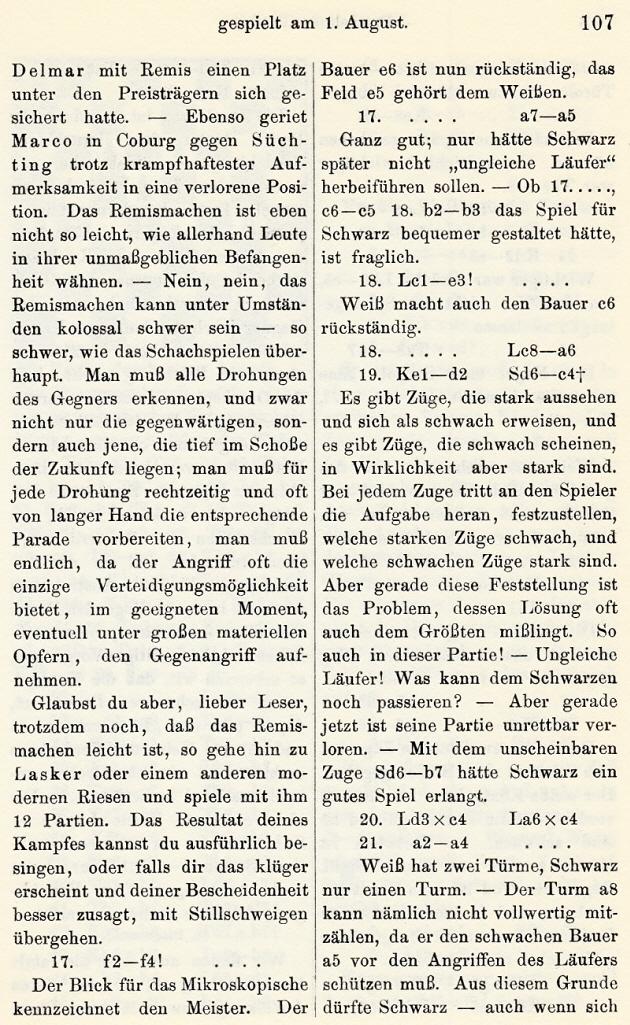
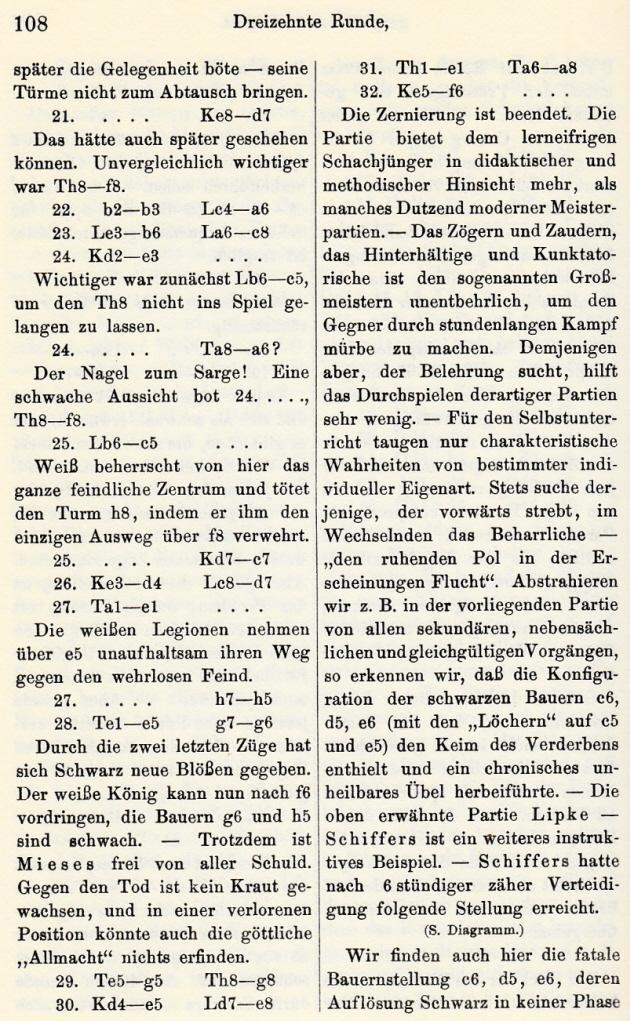
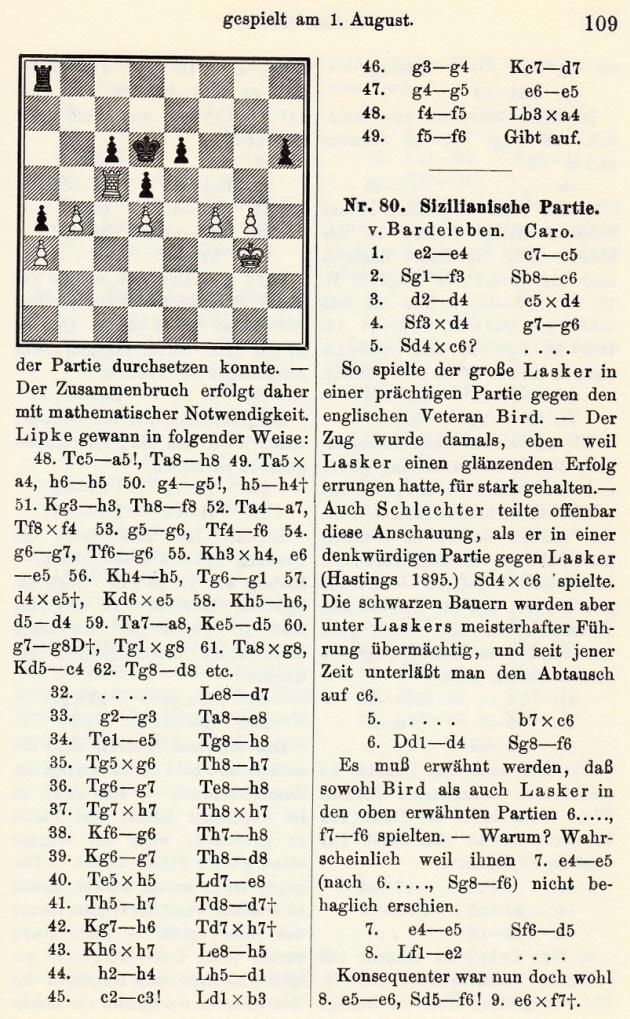
The notes were reproduced on pages 361-364 of the December 1905 Wiener Schachzeitung.
Next, Tartakower’s annotations from pages 36-39 of his monograph on Bernstein, Moderne Schachstrategie (Breslau, 1930):
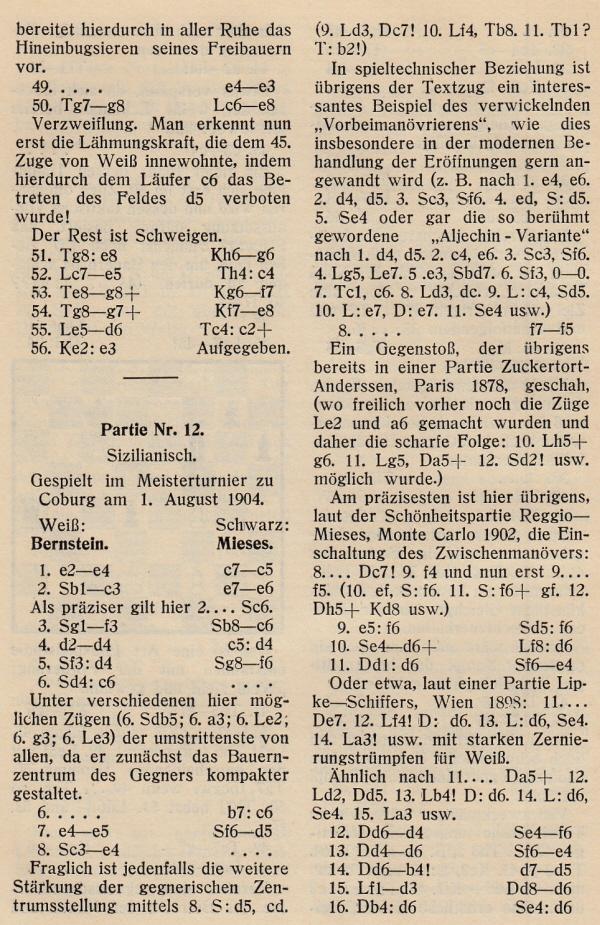
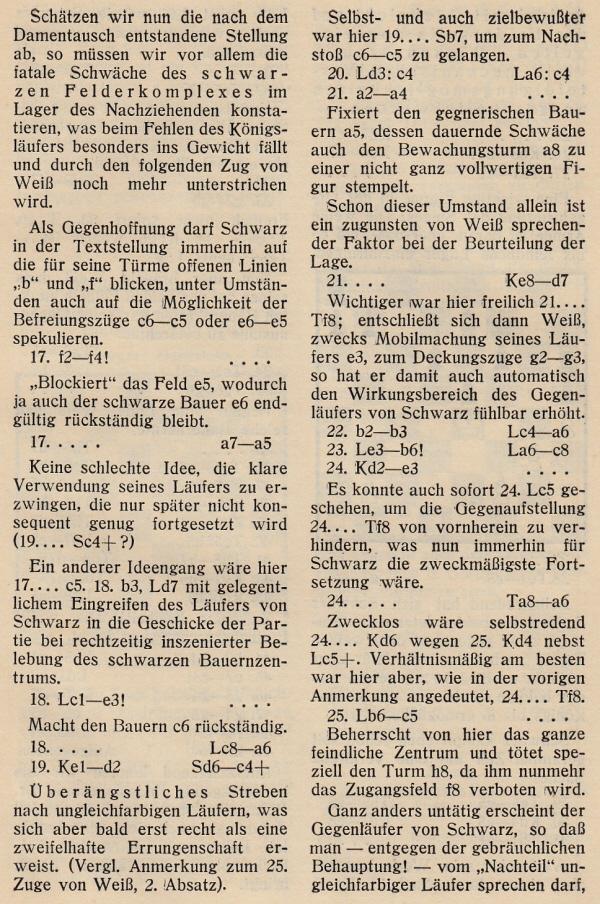


The score according to the above German-language sources was: 1 e4 c5 2 Nc3 e6 3 Nf3 Nc6 4 d4 cxd4 5 Nxd4 Nf6 6 Nxc6 bxc6 7 e5 Nd5 8 Ne4 f5 9 exf6 Nxf6 10 Nd6+ Bxd6 11 Qxd6 Ne4 12 Qd4 Nf6 13 Qd6 Ne4 14 Qb4 d5 15 Bd3 Qd6 16 Qxd6 Nxd6 17 f4 a5 18 Be3 Ba6 19 Kd2 Nc4+ 20 Bxc4 Bxc4 21 a4 Kd7 22 b3 Ba6 23 Bb6 Bc8 24 Ke3 Ra6 25 Bc5 Kc7 26 Kd4 Bd7 27 Rae1 h5 28 Re5 g6 29 Rg5 Rg8 30 Ke5 Be8 31 Re1 Ra8 32 Kf6 Bd7 33 g3 Rae8 34 Ree5 Rh8 35 Rxg6 Rh7 36 Rg7 Reh8 37 Rxh7 Rxh7 38 Kg6 Rh8 39 Kg7 Rd8 40 Rxh5 Be8 41 Rh7 Rd7+ 42 Kh6 Rxh7+ 43 Kxh7 Bh5 44 h4 Bd1 45 c3 Bxb3 46 g4 Kd7 47 g5 e5 48 f5 Bxa4 49 f6 Resigns.
The position after 26...Bd7:
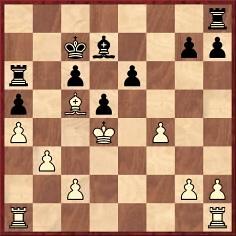
The Chernev books gave White’s 27th move as Rhe1 instead of Rae1.
A slightly different ending (without 46...Kd7) can also be found in some databases. Indeed, one database that we consulted offered three versions of the game, and none of them corresponded exactly to the moves in the tournament book.
As regards possible errors by Black, his 24th and 25th moves received question marks on page 45 of O.S. Bernstein (Grand maître international d’Echecs) by J. Cena:
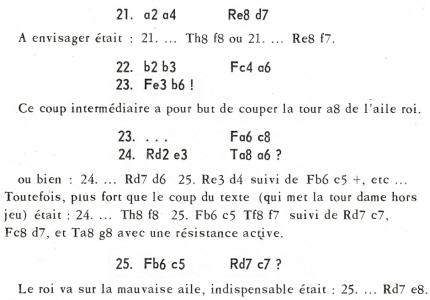
On the same page Cena gave 27 Rae1, and not 27 Rhe1. The privately-printed book contains no date or place of publication; it was listed for sale on page 83 of the March 1968 BCM.

Moves 19-40 of the game (with 27 Rhe1) can be found on pages 43-44 of Positional Chess Handbook by Israel Gelfer (London, 1991). The only move criticized was 19...Nc4+, which Cena had passed over in silence.
In Logical Chess Move by Move (see, for instance, page 180 of the 1998 algebraic edition published by B.T. Batsford Ltd.), Chernev pointed out that at move 11/13 (taking account of a repetition of moves) Alekhine suggested ...Qb6. We are not aware that Alekhine ever annotated, or even mentioned, the Bernstein v Mieses game, but he commented on the position when it arose in Yates v Emanuel Lasker at New York, 1924. From page 186 of the tournament book:

Finally, concerning Bernstein’s 17 f4 Chernev wrote on page 161 of The Most Instructive Games of Chess Ever Played:
‘It was about moves of this sort that the great annotator Marco said, “An eye for the microscopic betokens the master”.’
The quote was also included in Logical Chess Move by Move. From the above annotations in the Coburg, 1904 tournament book it will be seen that Marco’s comment in German was, on page 107:
‘Der Blick für das Mikroskopische kennzeichnet den Meister.’
8705. Nineteenth-century British players
Hans Renette (Bierbeek, Belgium) seeks information about the provenance of a picture on page 105 of Paul Morphy The Pride and Sorrow of Chess by David Lawson (New York, 1976):
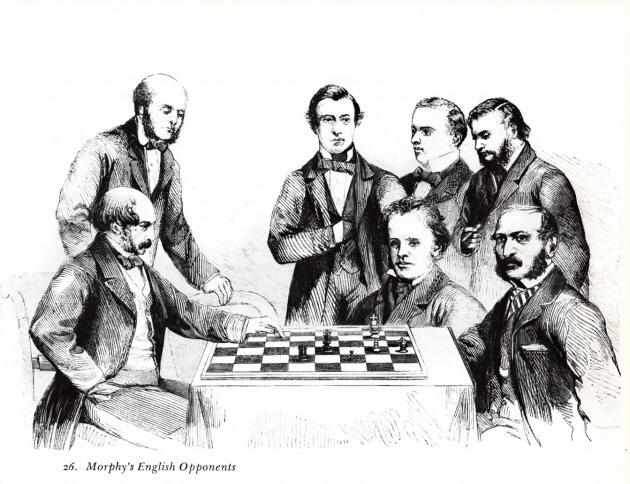
In the paperback edition (Lafayette, 2010) it was on page 190 (with a slightly different caption: ‘Paul Morphy’s British opponents’).
For purposes of comparison we add an illustration discussed in Pictures of Howard Staunton:
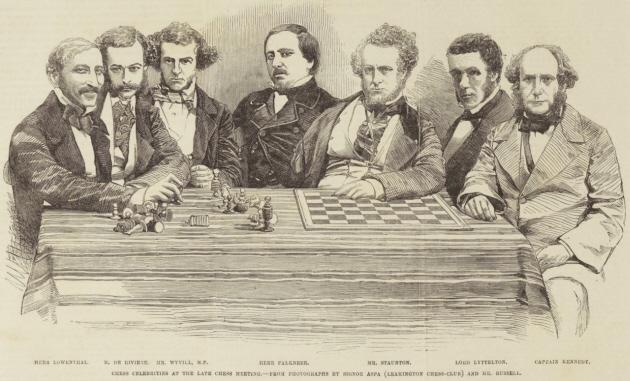
Source: Illustrated London News, 14 July 1855, page 44.
When this latter picture was given on page 85 of The World of Chess by Anthony Saidy and Norman Lessing (New York, 1974) the players were not identified, and the reader was merely informed:
‘Staunton (third from right) among cronies.’
8706. Mathew Brady
David Lawson’s writings on Morphy have many references to the photographer ‘Matthew Brady’. Although that spelling appears on, for instance, page 196 of the Chambers Biographical Dictionary edited by Magnus Magnusson (Edinburgh, 1990), we note that his forename was Mathew.
8707. Capablanca v Fonaroff
Concerning Capablanca v Fonaroff, New York, 1918, additions can be made to the long list of misspellings of Black’s name. ‘Fonarek’ occurs in a book by a team of authors which, moreover, gave the occasion as ‘New York Budapest, 1904’: page 86 of volume one of Ajedrez integral (Havana, 2003). The misinformation was repeated when the game re-appeared on pages 172-173. On pages 189-190 of volume two (Havana, 2005) the game was presented yet again, with another misspelling: ‘Capablanca-Fonaroll Nueva York, 1904.’
8708. Capablanca v Zirn
From page 299 of volume one of Ajedrez integral (Havana, 2003):

(For some reason, the book often repeated a game’s venue. Thus the following page had a game played in 1925 by Alekhine and Rabinovich at ‘Baden-Baden Baden-Baden’.)
The Capablanca v Zirn encounter comes from pages 43-44 of our book on the Cuban, which specified that the game-score, taken from Diario de la Marina, was a reconstruction proposed to us by Rob Verhoeven and Eliezer Agur.
Below, difficult to reproduce clearly, is Capablanca’s garbled column on page 11 of Diario de la Marina, 1 December 1912, which we found in the mid-1980s at the Biblioteca Nacional José Martí in Havana:

8709. Pin and counter-pin
Wanted: information about a position on pages 19-20 of book one of Test Your Chess IQ by A. Livshitz (Oxford, 1981):
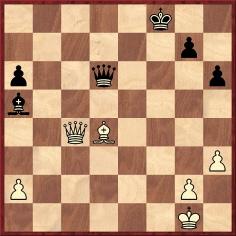
The conclusion was given as 1 Bc5 Bb6 2 Qf4+ Resigns, the game being identified as ‘Brundtrup [sic – Brüntrup] v Budrich, Berlin, 1954’.
8710. Peter Mark Roget (C.N.s 4283 & 4288)
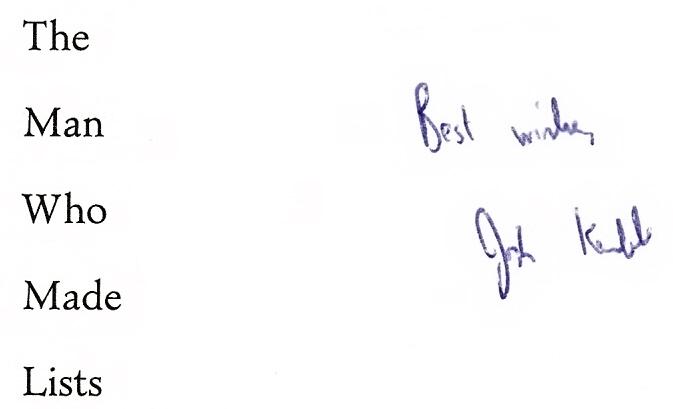
Eduardo Ramirez (Chicago, IL, USA) refers to The Man Who Made Lists by Joshua Kendall (New York, 2008), a biography subtitled ‘Love, Death, Madness, and the Creation of Roget’s Thesaurus’.
The Preface (page 1) describes Roget as ‘the eminent nineteenth-century polymath – physician, physiology expert, mathematician, inventor, writer, editor, and chess whiz’. Pages 203-206 relate Roget’s romance with Jane Griffin:
‘Here was a woman who, too, made a treasure chest of her ideas and had a penchant for classification. What’s more, Jane could play a mean game of chess. She had had a formidable instructor, Davies Giddy – later the president of the Royal Society during the beginning of Roget’s tenure as secretary – who never forgot her “wonderful quickness in learning chess”.’
Pages 174-175 state regarding Roget:
‘He even approached one of his favorite pastimes, chess, as if it were an academic discipline (decades later, he published the celebrated theoretical paper “Description of Moving the Knight over Every Square of a Chess-Board Without Going Twice over Any One” in a philosophical journal).’
Mr Ramirez comments that Roget’s paper was published in the London and Edinburgh Philosophical Magazine and Journal of Science, April 1840, that George Walker responded in the June 1840 issue, and that Roget was mentioned (in connection with the knight’s tour) by D.W. Fiske on page 44 of the New York, 1857 tournament book.
We add that the Roget was referred to on page 11 of the Chess Player’s Chronicle, 1841:
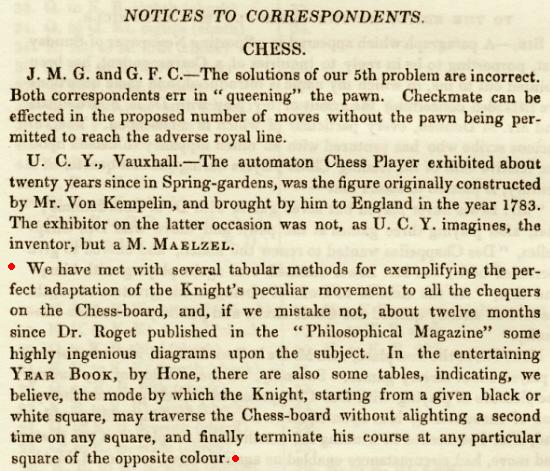
A new feature article, Peter Mark Roget and Chess, includes the full texts contributed by Roget and Walker to the London and Edinburgh Philosophical Magazine and Journal of Science in 1840.
8711. The Pillsbury attack (C.N.s 8699 & 8702)
Thomas Henrich (Gießen, Germany) notes a document on the history of chess in the Oberfranken area which lists Wolfgang Fleischmann of Weiden as the champion of Oberfranken in 1938 and 1939.
8712. Fidel Castro on chess
The front covers of both volumes of Ajedrez integral mentioned in C.N.s 8707 and 8708 have a quotation ascribed to Fidel Castro (‘Masificar el ajedrez colocaría a este país con mucha más capacidad de pensar, más eficiente; es como saber una asignatura básica’). Page 13 of volume one also offers: ‘el ajedrez te coloca a cada instante ante la necesidad de resolver el problema.’

It will be appreciated if readers can help us build up an authoritative list of remarks about chess by Castro, i.e. in the fully-sourced, bilingual format adopted in The Most Famous Chess Quotations.
8713. Correspondence chess
From page 243 of CHESS, April 1966:
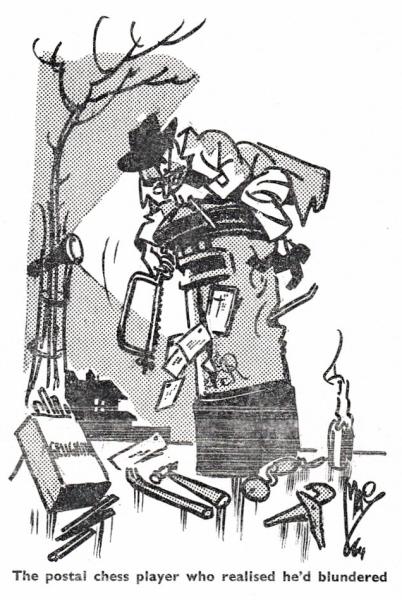
8714. Video of Najdorf interview
Further to Confusion over Alekhine v Najdorf, Christian Sánchez (Rosario, Argentina) reports that an account by Najdorf in a 1997 interview is available on-line.
8715. A missed opportunity
From page 58 of Blunders and Brilliancies by Ian Mullen and Moe Moss (Oxford, 1990):

The co-authors did not state their source for the position. Such a finish (with the move ...Be3 overlooked) did occur in a game (Berlin, 1918) between the players named, but Schlechter was White. The position, moreover, was slightly different:
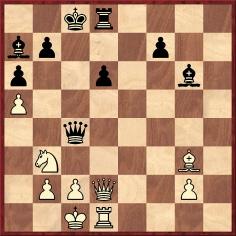
The game was annotated by Emanuel Lasker (who mentioned the players’ extreme time-trouble at move 30) on pages 14-15 of Das Großmeister-Turnier im Kerkau-Palast zu Berlin im Oktober 1918:
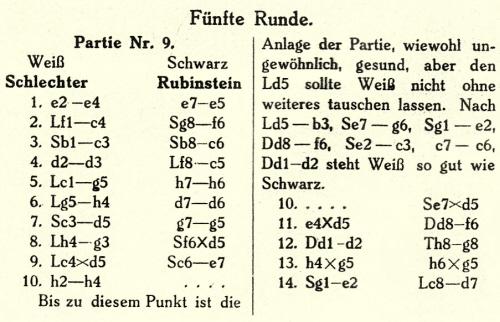
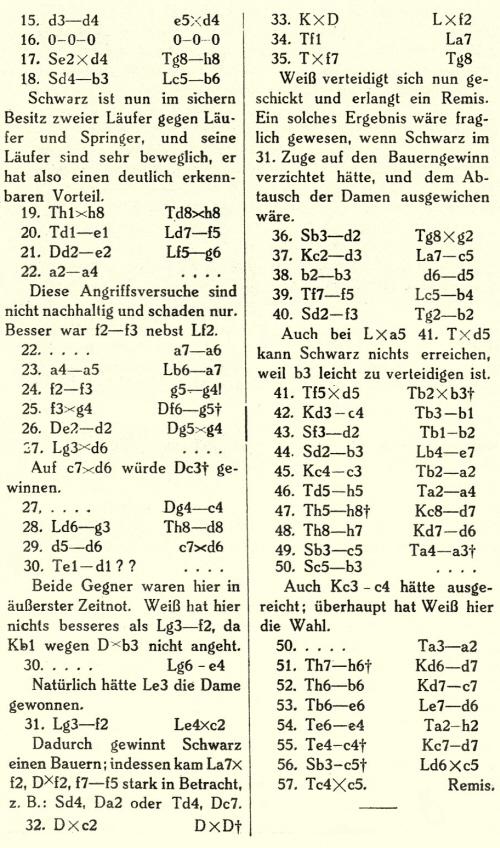
See too page 321 of volume one of The Life & Games of Akiva Rubinstein by John Donaldson and Nikolay Minev (Milford, 2006).
8716. Nimzowitsch on pinned pieces
Concerning the Nimzowitsch quote given by Mullen and Moss (C.N. 8715), the following appeared in the chapter on pins in My System, e.g. on pages 96-97 of the original English-language edition (London, 1929):
‘A pinned piece’s defensive power is only imaginary. He only makes a gesture as if he would defend; in reality he is crippled and immobile. Hence we may confidently place our piece en prise to a pinned piece, for he dare not lay hands on it.’
From page 133 of Nimzowitsch’s original text, Mein System (Berlin, 1925):
‘Ein gefesselter Stein deckt nur imaginär. Er tut nur so, als ob er decken würde; in Wirklichkeit ist er ja gelähmt und unbeweglich. Daher darf man seine eigenen Offiziere getrost en prise stellen; der gefesselte Stein darf doch nicht zugreifen.’
A different wording in English, ‘The defensive power of a pinned piece is only imaginary’, was given as a Nimzowitsch quote on page 7 of Winning Chess by Irving Chernev and Fred Reinfeld (New York, 1948). On page 61 of A First Book of Morphy (Victoria, 2004) Frisco Del Rosario attributed the remark ‘The defensive power of a pinned piece is illusory’ to Reinfeld.
8717. Morphy’s memory
Part of an article ‘Sketches from the Chess World’ by Ernst Falkbeer on pages 53-54 of the June 1881 issue of Brentano’s Chess Monthly:
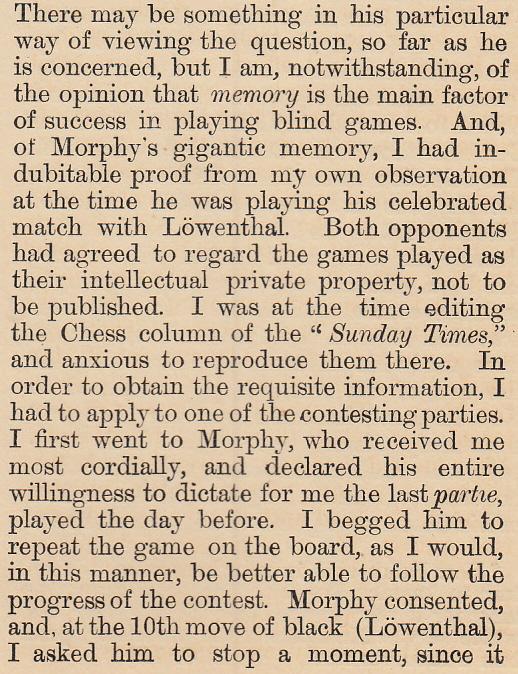
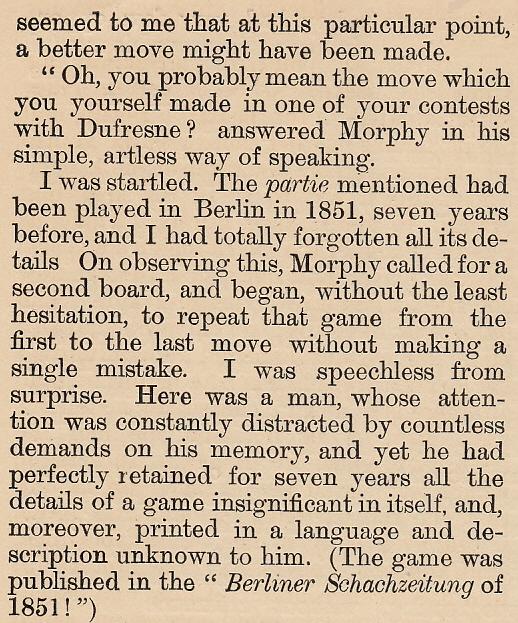
The article was translated from the Deutsche Illustrirte Zeitung, and we wonder whether the details about the memory episode can be verified.
The Morphy v Löwenthal match conditions did indeed stipulate that the games were the joint property of the players, as reported in Löwenthal’s column in the Era, 18 July 1858, page 13:
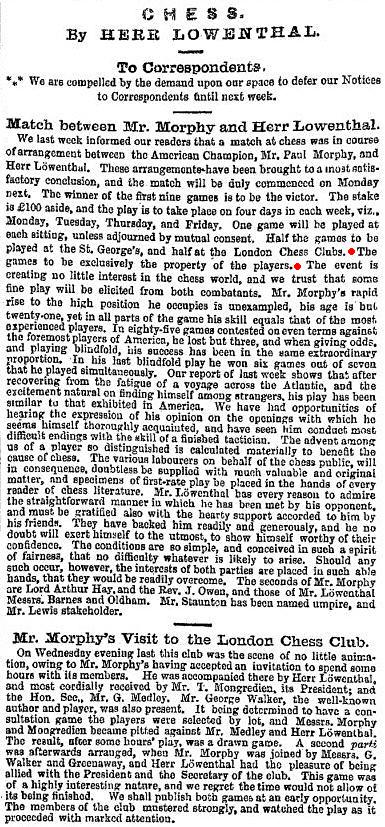
See too page 284 of the Chess Monthly, September 1858 and page 108 of David Lawson’s biography of Morphy (New York, 1976).
Below is the first column by Falkbeer to give a game from the Morphy v Löwenthal match (Sunday Times Supplement, 8 August 1858, page 4):
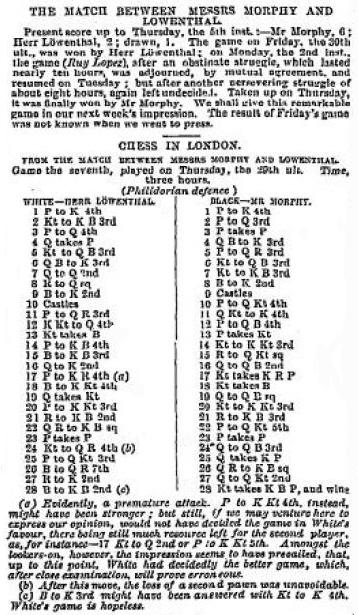
We have yet to find anything of relevance to the Falkbeer/Dufresne matter in any columns in the Era or Sunday Times from 1858, in Max Lange’s book on Morphy (London, 1860), which was translated and adapted by Falkbeer, in the collection of Morphy’s games by Löwenthal (London, 1860), or in any periodicals published in 1851.
8718. Misplaced knight
C.N. 2370 (see page 162 of A Chess Omnibus) commented that many beginners’ books, especially from the United States, give the advice ‘A knight on the rim is grim’. As an addition we suggested: ‘A knight in the corner is forlorner.’ A subsequent item (C.N. 6877) mentioned that both ‘grim’ and ‘dim’ are to be found, and that the latter version appeared, in quotation marks, on page 17 of the January 1963 Chess Review and on page 175 of the magazine’s June 1964 issue. In both cases the writer was Al Horowitz.
What more can be discovered about the maxim?
A third possibility, with ‘trim’, was given by William Lombardy on page 121 of the April 1969 Chess Review:
‘Tinsley has said: “Knight on the rim equals trim.”’
Lombardy also quoted the ‘trim’ wording on page 134 of Modern Chess Opening Traps (New York, 1972), adding ‘Tinsley, circa 1880’. On what basis?
On page 237 Lombardy offered a different, anonymous rhyme:
‘A knight on the side one cannot abide’, goes the adage.
That ‘adage’ had been put forward on page 96 of Chess Marches On! by Reuben Fine (New York, 1945), in a note to 26 Qe2 in Lilienthal v Keres, USSR Absolute Championship, 1941:
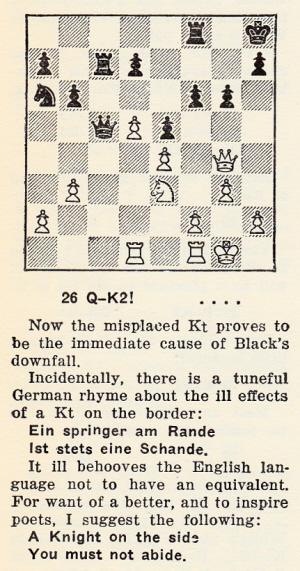
Such a German text was attributed to Tarrasch on page 77 of Dynamic Chess Strategy by Mihai Şubă (Alkmaar, 2010), in a discussion of the game García Padrón v Şubă, Las Palmas, 1979:
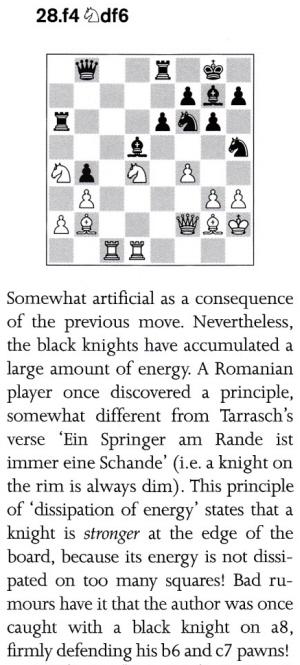
The German observation occurs, in quotation marks, in the unsigned notes to Marco v Taubenhaus, Monte Carlo, 1903, on page 109 of the April 1903 Deutsche Schachzeitung:

8719. Benko v Lombardy
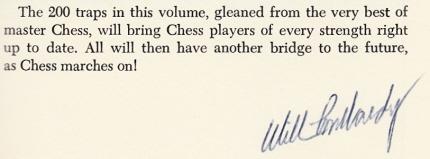
Above, at the end of his Preface, is William Lombardy’s signature in our copy of Modern Chess Opening Traps (C.N. 8718), which was later published in the United Kingdom by B.T. Batsford Ltd. under the title Snatched Opportunities on the Chessboard.
In most of the 200 games the players’ names are omitted, but an exception, on pages 304-308, is Lombardy’s ‘mini-delayed brilliancy’ against Benko, introduced as follows:
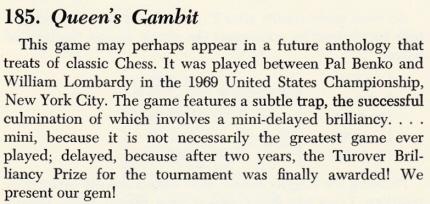

Position before 22...Bf3.
Even this notable game is mishandled by some databases (‘USA, 1970’). It was played on 14 December 1969, in the ninth round of the US Championship in New York, as shown in a table on page 9 of Morton Siegel’s tournament book.
From pages 52-53 of that work:

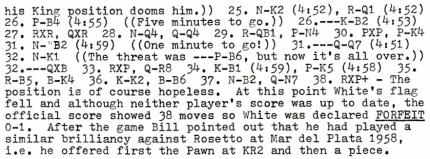
Regarding clock times, page 6 gave this explanation:
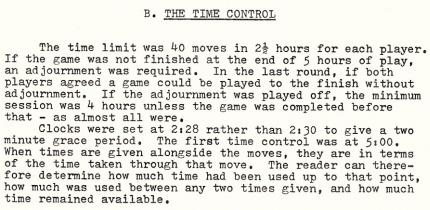
Lombardy annotated the game on pages 211-213 of Understanding Chess. My System, My Games, My Life (New York, 2011).
8720. The strength of the fianchetto
Examples of chess instruction which have an original or unusual slant are always welcome.
Page 16 of One Hundred Chess Maxims by C.D. Locock (Leeds, 1930) stated:
‘A fianchetto bishop (at Kt2, behind a pawn at Kt3) owes its great strength to its being unapproachable by a knight.’
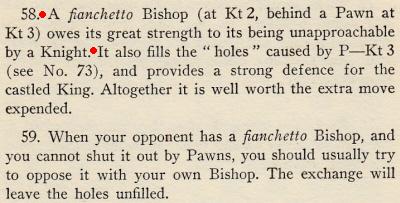
8721. Fischer caricature
Information is sought about this picture, from page 277 of CHESS, July 1972:
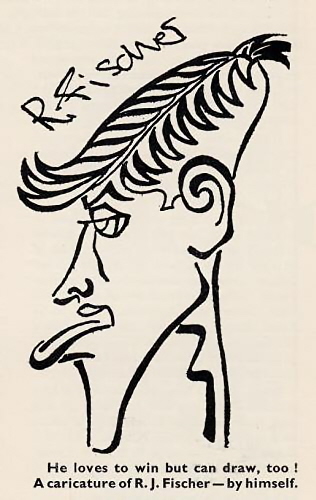
8722. A mysterious book (C.N.s 3087, 4991 & 5004)
Pedro Pinto Basto (Corroios, Portugal) requests further information about a book reportedly found next to Alekhine’s body in his hotel room in Estoril in 1946.
Below are the two passages referred to in C.N.s 3087 and 4991, from pages 70 and 84 of Xeque-Mate no Estoril by Dagoberto L. Markl (Porto, 2001):


We have looked unsuccessfully for a French equivalent of ‘Este é o destino de todos os que vivem no exílio’/‘Este é o destino dos que vivem no exílio’ in the book in question (a 381-page novel), Vers L’Exil by Margareth Sothern (Paris, 1939).
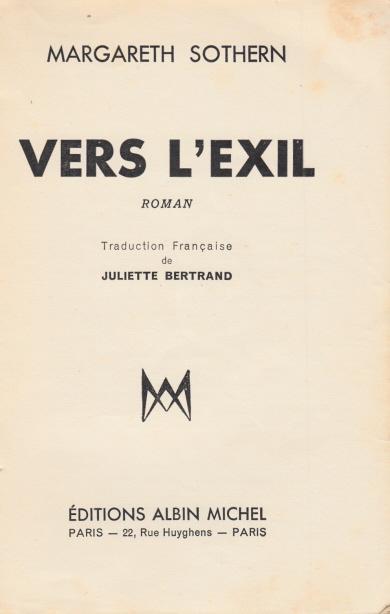
8723. Schlechter v Riedhof
Page 181 of Schachjahrbuch für 1905 II. Teil by L. Bachmann (Ansbach, 1906):

1 d4 d5 2 c4 dxc4 3 Nf3 e6 4 e3 Nf6 5 Bxc4 Bd6 6 Nc3 O-O 7 O-O Nc6 8 e4 e5 9 d5 Ne7 10 Qc2 Ng6 11 Be3 h6 12 Rac1 a6 13 a3 Nh5 14 Ne2 f5 15 Bd3 f4 16 Bc5 Bg4 17 Bxd6 cxd6
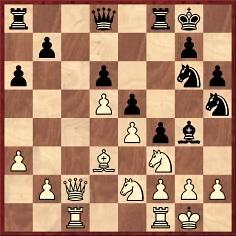
18 Qc7 Bxf3 19 Qxd8 Raxd8 20 gxf3 Nh4 21 Rc7 Nxf3+ 22 Kh1 Rf7 23 Rfc1 Rdd7 24 Rc8+ Kh7 25 Nc3 Ng5 26 Na4 f3 27 Nb6 Rde7 28 Nc4 Rd7 29 Ne3 Rde7 30 Rd8 Rc7 31 Rc8 Rxc1+ 32 Rxc1 Nf4 33 Bb1 Ne2 34 Rf1 Nh3 35 Nc4 Rc7 36 Nd2
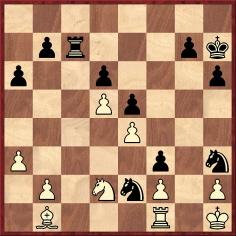
36...Rc1 37 White resigns.
Details are sought. The news item below comes from page 188 of the June 1905 Deutsche Schachzeitung.

8724. Fischer caricature (C.N. 8721)

Rudy Bloemhard (Apeldoorn, the Netherlands) has found the website of Marina Petric, which states that the Fischer caricature was by her late father, Berislav Petric.
8725. The Tinsleys
The obituary of Samuel Tinsley on pages 158-159 of the April 1903 BCM reported:
‘The mortal remains of Mr Tinsley were interred on 4 March at Lewisham Cemetery, after a service at Lewisham Road Baptist Church, into which the body, enclosed in an English oak panelled coffin with brass fittings, was borne on the shoulders of deceased’s sons, Messrs. Edward, Samuel, Henry and Frank Tinsley.’
Page 503 of the October 1937 BCM published an obituary of Edward Tinsley:
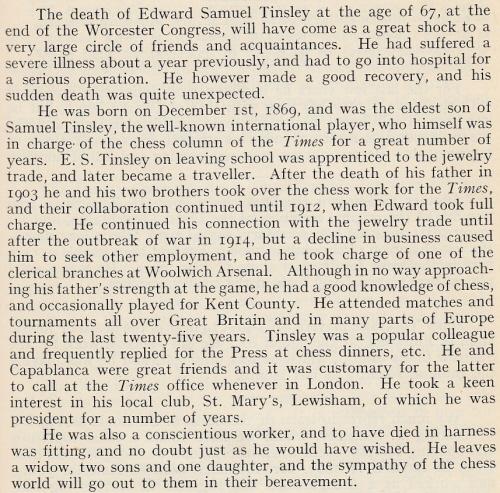
C.N.s 45 and C.N. 593 (see page 272 of Chess
Explorations) referred to Capablanca and Fine’s
views of Edward Tinsley. The opinion of William Winter was
quoted on page 245 of our book, from C.N. 1197. See too
G.H. Diggle’s article ‘Old Tinsley’ in the June 1979 Newsflash
and on page 48 of Chess Characters (Geneva, 1984).
Chess and Radio quotes, from two January 1926 issues of the Chess Budget, brief references to a British Broadcasting Company talk on chess by one of Edward’s brothers, Samuel. We have now found a transcript, in an improbable place: the chapter entitled ‘The Indian Ocean’ in his travel book Across the World (London, 1937).
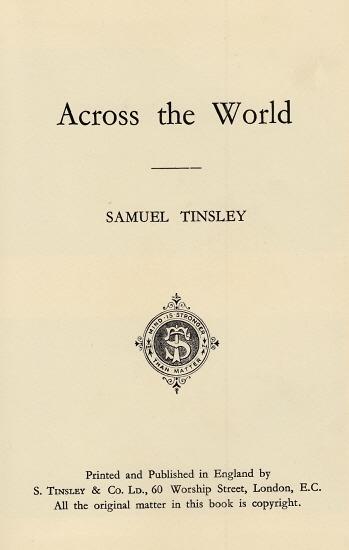
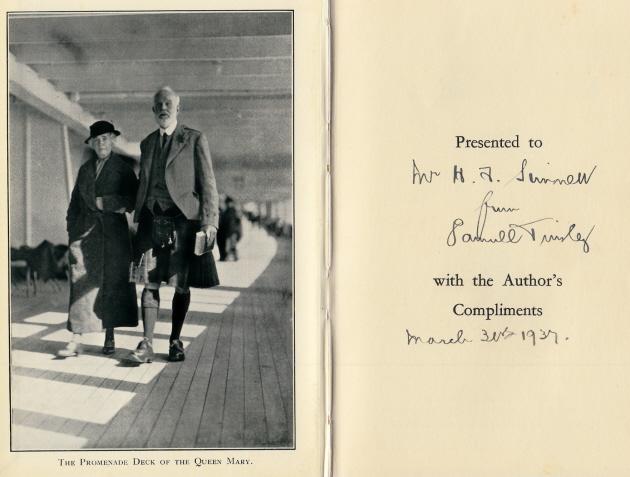
The full text:
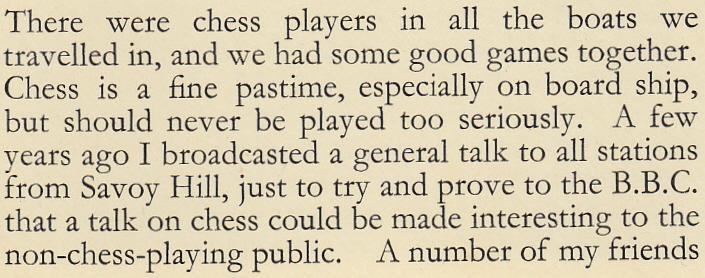
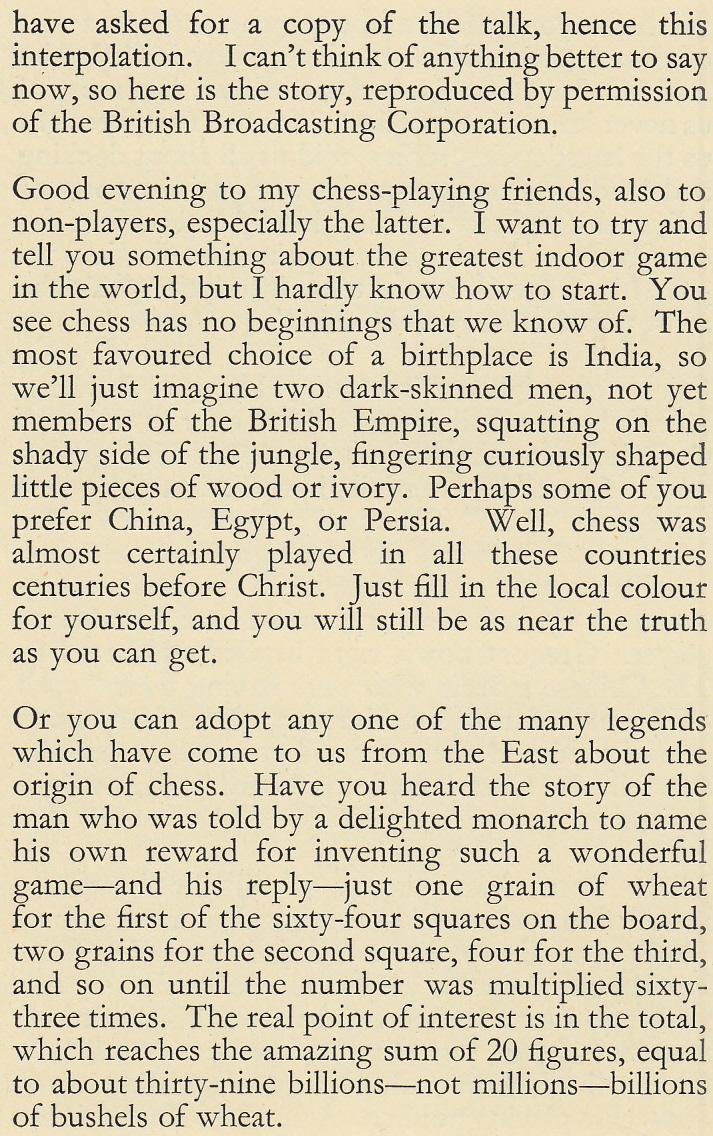

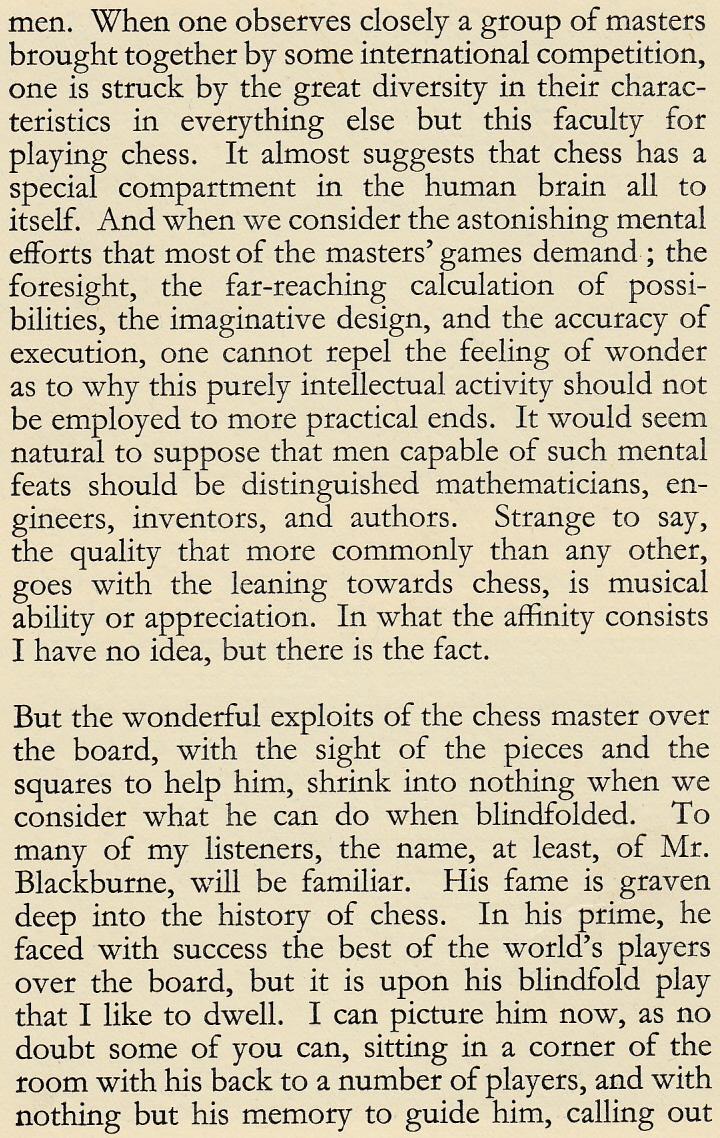
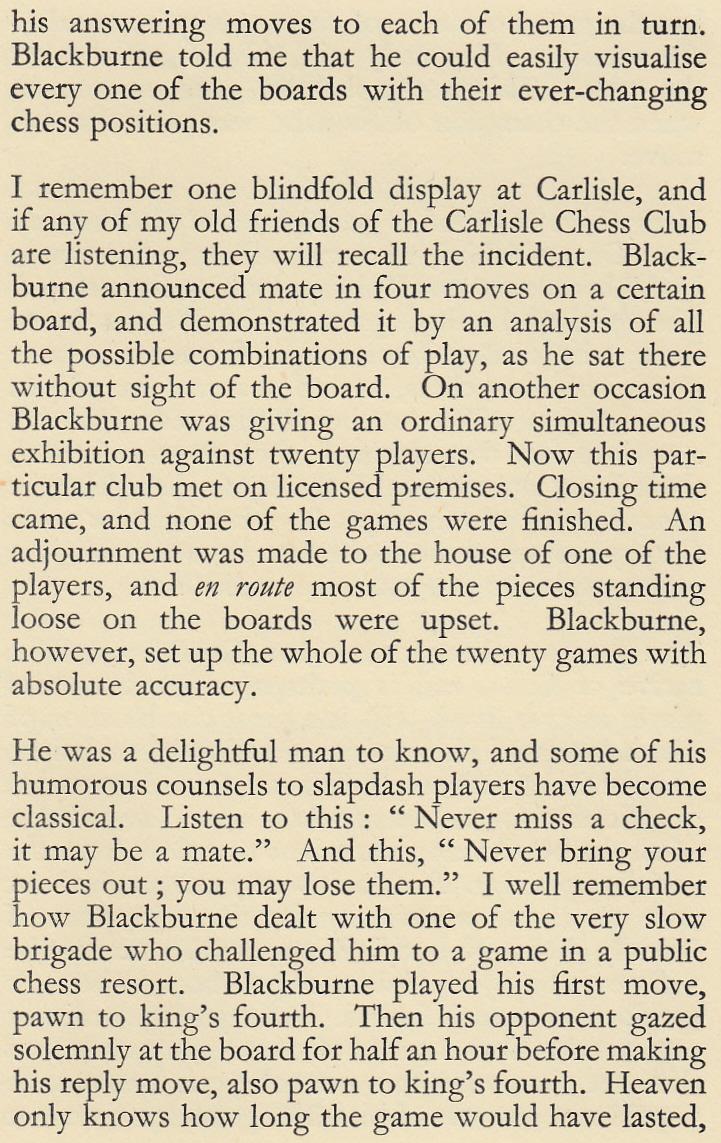
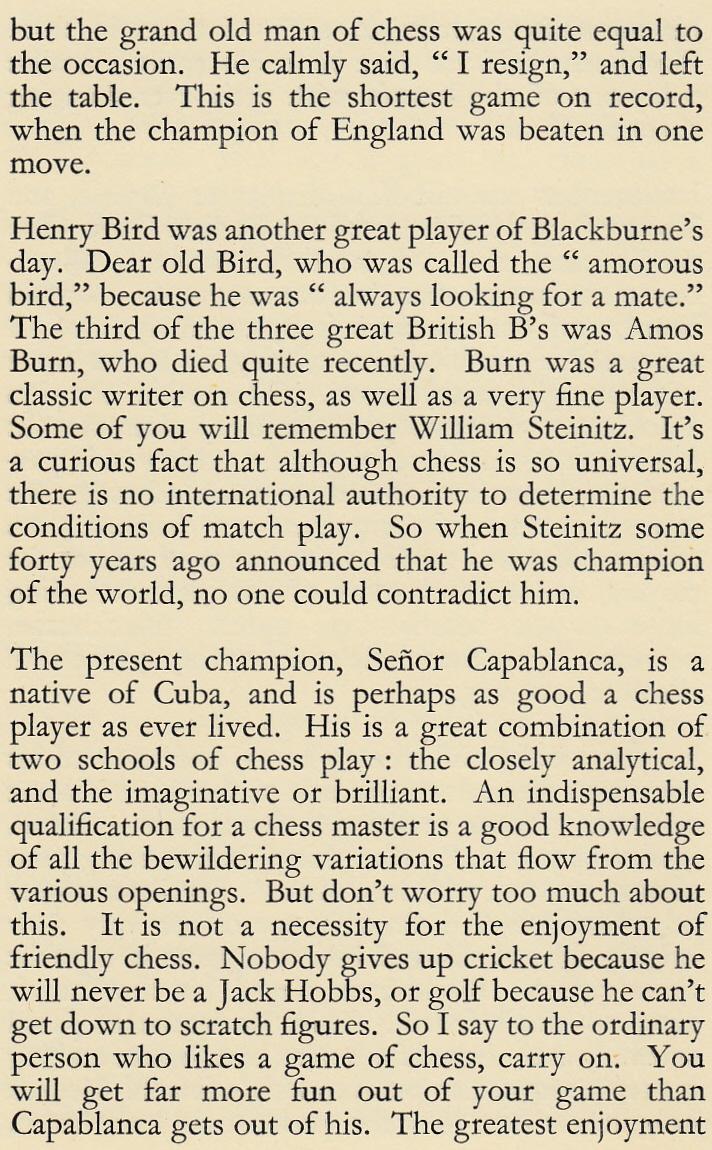

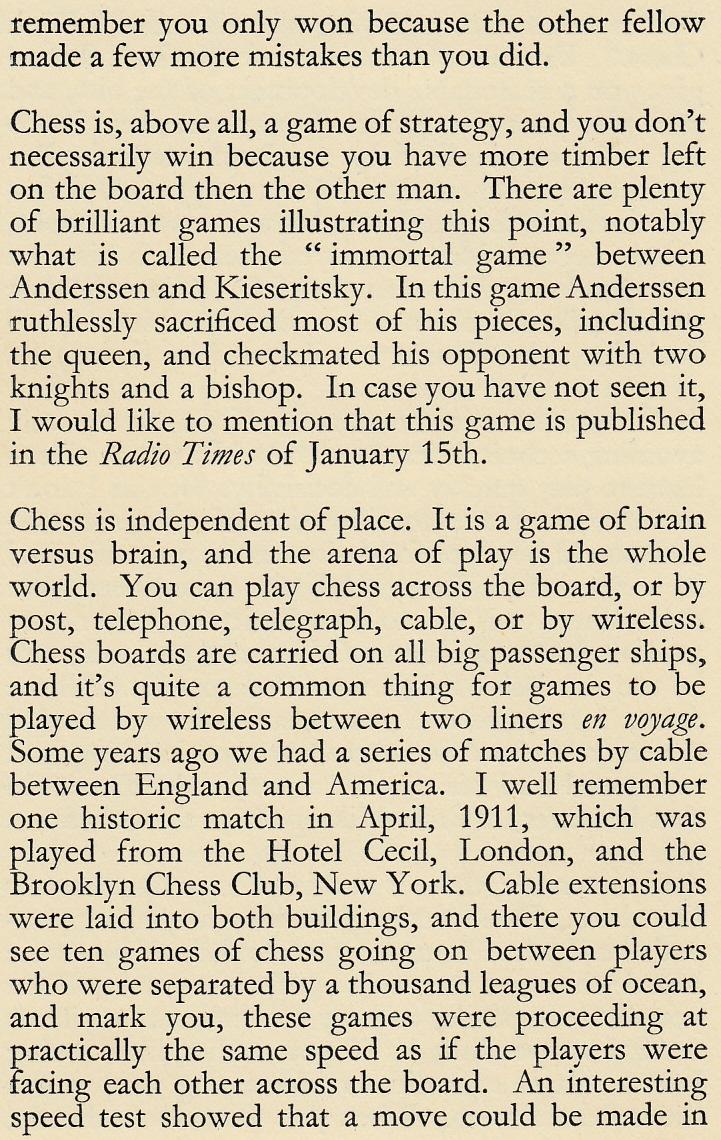
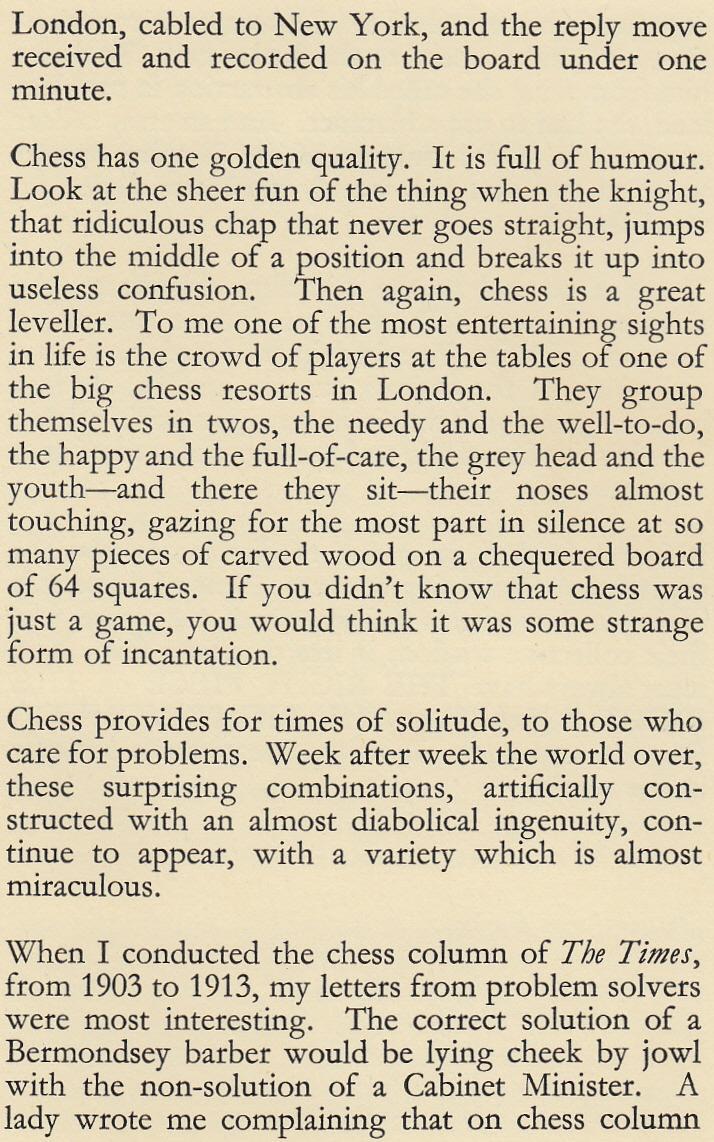

Some gleanings from the above pages (which were unnumbered):
- ‘I have met or seen most of the foremost chess masters during the past 35 years, and I don’t think I ever knew one who really cared to go over a game which he had lost.’
- ‘Never bring your pieces out; you may lose them.’ (Remark attributed by Tinsley to Blackburne.)
- ‘Half the time spent over delayed moves is due to mere hesitation, and not to profound consideration.’
- ‘There is nothing shows up character like chess.’
- ‘When you do lose, smile, and try to make the smile as natural as possible, as if you rather liked being beaten. It is splendid moral training, and worth thousands of wins.’
- ‘Chess is a great leveller. To me one of the most entertaining sights in life is the crowd of players at the tables of one of the big chess resorts in London. They group themselves in twos, the needy and the well-to-do, the happy and the full-of-care, the grey head and the youth – and there they sit – their noses almost touching, gazing for the most part in silence at so many pieces of carved wood on a chequered board of 64 squares.’
- ‘Tens of thousands of books have been written about
the game, but their collective wisdom is less than just
this. You must always have the right piece on the
right square at the right moment. Do this,
and you will be the greatest chessplayer in the world.’
(See C.N. 8415.)
8726. Bombs
Regarding the familiar quotation ‘Discovered check is the dive-bomber of the chess board’, the exact wording on page 112 of Chess The Easy Way by Reuben Fine (Philadelphia, 1942) was:
‘Discovered check. This is one of the most destructive devices that anybody can think up – it is the dive-bomber of the chess board.’
A variant appeared on page 15 of Fine’s The Middle Game in Chess (Philadelphia, 1952):
‘Discovered check. This is one of the most destructive devices available to the player – it is the hydrogen bomb of the chessboard.’
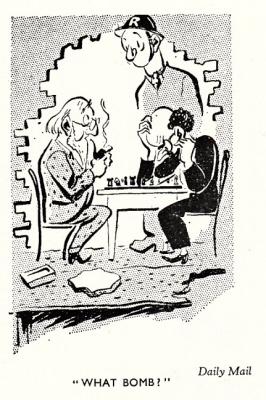
CHESS, January 1943, page 52.
8727. Without comment
From a letter contributed by Clayton Blackburn, Rahway, NJ, on page 2 of the November 1945 Chess Review, concerning the USA-USSR radio match:
‘We used the atomic bomb on the Japs, but our Russian comrades used Botvinnik with equal devastation on us.’
8728. A.G. Laing
Our archives include two score-books in which A.G.
[Andrew] Laing recorded his games in the 1930s and 40s.
His opponents included Vera Menchik, Jacques Mieses and
Sir George Thomas, and an example follows, from a
simultaneous display:

Sir George Thomas – A.G. Laing
London, 9 January 1943
Sicilian Defence
1 e4 c5 2 Nc3 Nc6 3 g3 e6 4 Bg2 Nf6 5 d3 d5 6 Bg5 d4 7 Nce2 h6 8 Bxf6 Qxf6 9 Nf3 e5 10 O-O Bg4 11 Ne1 O-O-O 12 h3 Bd7 13 f4 exf4 14 Nxf4 Bd6 15 Qd2 g5 16 Nd5 Qe5 17 Rf3 h5 18 Nf6 Be6 19 Qf2 g4 20 hxg4 hxg4 21 Rf4 Qg5
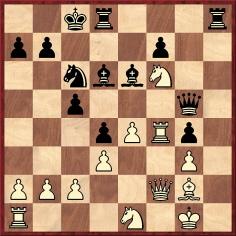
22 Nd5 Bxf4 23 Nxf4 Ne5 24 c3 Qh6 25 Kf1 Rd6 26 Rc1 dxc3 27 Qxc5+ Kd7 28 Qxe5 cxb2 29 Qxb2 b6 30 Qc3 Ke7 31 d4 Rc8 32 Qd2 Rxc1 33 Qxc1 Rxd4 34 Nd5+ Resigns.
From page 31 of the February 1943 BCM:
‘Sir George Thomas played 21 members of the West London Chess Club on 9 January, at 23 Stratford Road, N8.’
8729. Sammy Rubinstein v Leonard Barden
Alan McGowan (Waterloo, Canada) draws attention to a photograph on page 36 of the 1-2/1953 issue of FIDE Revue:

8730. ‘The pin is mightier than the sword’ (C.N.s 3599, 3625, 4313 & 7799)
The saying ‘The pin is mightier than the sword’ (which has been traced back to Fred Reinfeld in 1948 – see C.N. 7799) has occasionally been attributed to Al Horowitz. For instance, on page 45 of the January 1975 Chess Life & Review Walter Meiden and Norman Cotter wrote:
‘The late Al Horowitz, who was publisher of Chess Review, used to say: “The pin is mightier than the sword”.’
And from page 79 of The Art of Positional Play
by Samuel Reshevsky (New York, 1976):
‘The late I.A. Horowitz used to quip: “The pin is mightier than the sword”.’
Loose claims about what people ‘used to’ say/quip obviously lack credibility, and Horowitz himself attributed the phrase to Reinfeld:
‘... there are pins and pins, despite Reinfeld’s dictum that “the pin is mightier than the sword”.’
Source: page 70 of Chess for Beginners by I.A. Horowitz (New York, 1950).
8731. Nullification
A remark commonly attributed to Al Horowitz is ‘One bad move nullifies 40 good ones.’
The only citation available to us is an article of his on
pages 339-341 of the November 1961 Chess Review,
which called the remark an ‘adage’:

8732. Trompowsky and Ruth
Below is a comment on 1 d4 Nf6 Bg5 from page 43 of Power Mates by Bruce Pandolfini (New York, 1996):
‘This is called Trompowsky’s Attack internationally, but Americans know it as Bill Ruth’s Opening. The Camden, New Jersey, Master was playing his opening back in the early 1920s, long before Trompowsky arrived on the scene. Ruth liked its offbeat qualities and the chance to weave some tricky traps. These same attractions hold good today.’
William Allen Ruth (1886-1975) was also mentioned in this context on page 57 of America’s Chess Heritage by Walter Korn (New York, 1978):
‘He made a name for himself in early-American opening theory by popularizing the Ruth Opening 1 P-Q4 N-KB3 2 B-N5, which in later epochs of unlimited means of publicity was “adopted” as the Trompovsky or the Veressov Opening.’
On several occasions Robert Byrne gave Ruth credit for the opening. From his column on page v 15 of the New York Times, 17 January 1993:
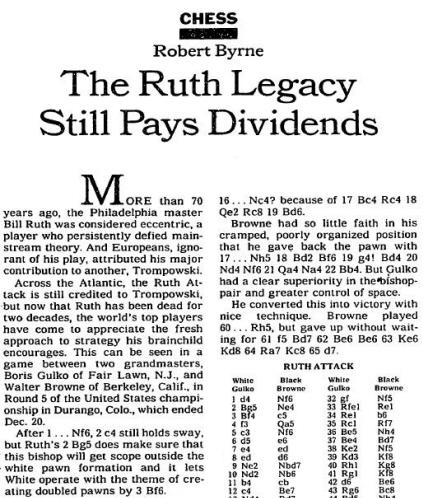
On page C5 of the 17 January 1995 edition Byrne wrote:
‘Seventy years ago the Philadelphia master Bill Ruth promulgated the move 2 Bg5, which makes sure that the white queen bishop will obtain scope outside the pawn formation. It also creates the option of Bf6, forcing doubled pawns. The most active counter-measure is 2...Ne4.’
What can be traced about Ruth’s use or advocacy of 1 d4 Nf6 2 Bg5 in the 1920s? (Games from the 1930s can be found; see, for instance, Ruth v Elo, Milwaukee, 1935, on pages 20-21 of the tournament book.)
As shown in the cutting above, Byrne wrote ‘Ruth Attack’. In his column on pages 26-27 of the May 1996 Chess Life he put ‘Ruth Opening’:

The Miles v Conquest game was played in the second round of the Hastings, 1995-96 tournament, on 29 December 1995; the results were reported in the following day’s edition of the Guardian, page 19.
On page 29 of the November 1995 Chess Life Edmar Mednis referred to 1 d4 Nf6 2 Bg5 as the ‘Trompowsky-Ruth Attack’, whereas on page 290 of Chess Thinking (New York, 1995) Bruce Pandolfini called it the ‘Ruth-Trompowsky Attack’. Editions of Modern Chess Openings have presented a range of contradictory information, and page 441 of the 13th edition (London, 1990), edited by Walter Korn and revised by Nick de Firmian, introduced another player as a ‘co-author’ of the opening:
‘The Trompowski Attack was co-authored by Opočenský (along with Trompowski) in the 1930s, but long before them it was consistently propagated by the American W.A. Ruth.’
The passage thus also introduced another verb, ‘propagate’, to join ‘popularize’ and ‘promulgate’ as descriptions of Ruth’s activity with 1 d4 Nf6 2 Bg5, but where are the hard facts?
Our earlier material on Trompowsky’s use of the opening has been brought together with the present item in The Trompowsky Opening, so that, within a single article, it is possible to peruse the entire nomenclatural shambles.
8733. Photographic chess boards
The Good Companion Two-Mover by G. Hume and A.C. White (Stroud, 1922) had two photographic chess boards, and we are grateful to the Cleveland Public Library for providing high-resolution scans:

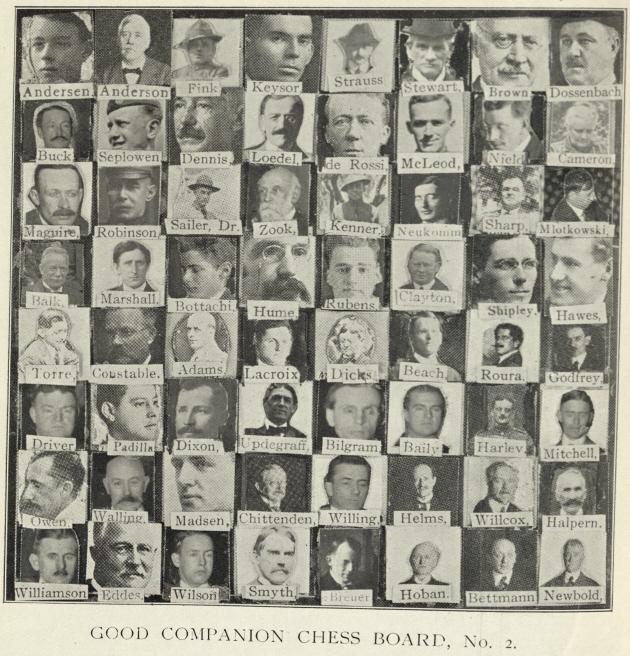
8734. Schlechter in Prague (C.N. 8723)
Peter Anderberg (Harmstorf, Germany) has found the Schlechter v Riedhof score on page 25 of Bohemia, 28 May 1905, together with three other games played by Schlechter in the same simultaneous exhibition (which was on 22 May, and not 21 May as stated in the Deutsche Schachzeitung news item reproduced in C.N. 8723).
First, a general report, from page 7 of Bohemia (morning edition), 25 May 1905:

Below are the games as published by Bohemia on 28 May 1905:
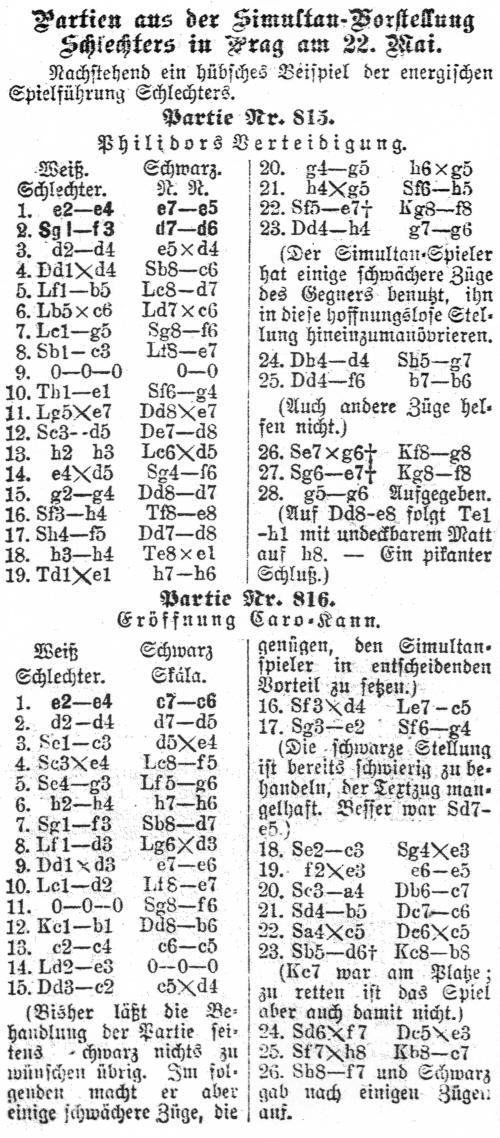
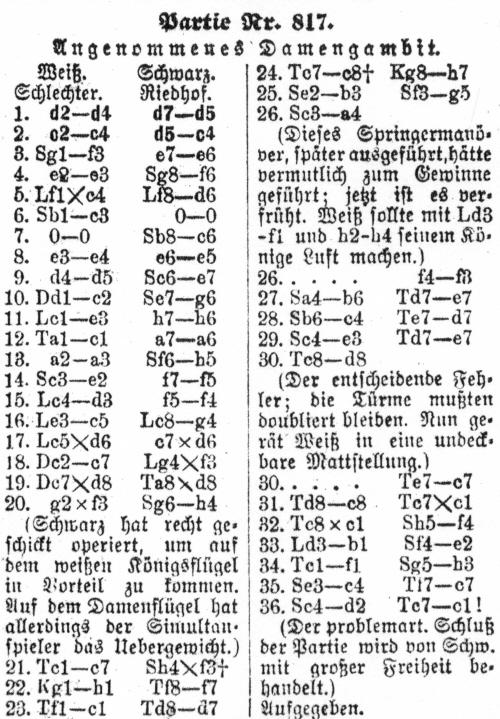


Carl Schlechter – N.N.
Prague, 22 May 1905
Philidor’s Defence
1 e4 e5 2 Nf3 d6 3 d4 exd4 4 Qxd4 Nc6 5 Bb5 Bd7 6 Bxc6 Bxc6 7 Bg5 Nf6 8 Nc3 Be7 9 O-O-O O-O 10 Rhe1 Ng4 11 Bxe7 Qxe7 12 Nd5 Qd8 13 h3 Bxd5 14 exd5 Nf6 15 g4 Qd7 16 Nh4 Rfe8 17 Nf5 Qd8 18 h4 Rxe1 19 Rxe1 h6 20 g5 hxg5 21 hxg5 Nh5 22 Ne7+ Kf8
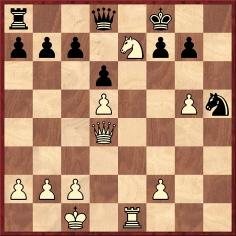
23 Qh4 g6 24 Qd4 Ng7 25 Qf6 b6 26 Nxg6+ Kg8 27 Ne7+ Kf8 28 g6 Resigns.
Carl Schlechter – Skála
Prague, 22 May 1905
Caro-Kann Defence
1 e4 c6 2 d4 d5 3 Nc3 dxe4 4 Nxe4 Bf5 5 Ng3 Bg6 6 h4 h6 7 Nf3 Nd7 8 Bd3 Bxd3 9 Qxd3 e6 10 Bd2 Be7 11 O-O-O Ngf6 12 Kb1 Qb6 13 c4 c5 14 Be3 O-O-O 15 Qc2 cxd4 16 Nxd4 Bc5 17 Nge2 Ng4 18 Nc3 Nxe3 19 fxe3 e5

20 Na4 Qc7 21 Nb5 Qc6 22 Nxc5 Qxc5 23 Nd6+ Kb8 24 Nxf7 Qxe3 25 Nxh8 Kc7 26 Nf7 Resigns.
Carl Schlechter – Ladislav Prokeš
Prague, 22 May 1905
Queen’s Gambit Declined
1 d4 d5 2 c4 e6 3 Nc3 Nf6 4 Bg5 Nbd7 5 e3 c6 6 Nf3 Qa5 7 Bxf6 Nxf6 8 Nd2 Bb4 9 Qc2 O-O 10 Bd3 dxc4 11 Nxc4 Qg5 12 O-O Qh4 13 h3 Nd5 14 Ne5 Bd6 15 Nxd5 Bxe5 16 dxe5 exd5 17 f4 f6 18 exf6 Rxf6 19 f5 Qg5 20 Rf3 Bd7 21 Raf1 Re8 22 Qf2 c5 23 b3
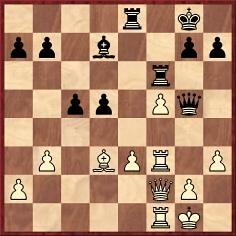
23...b5 24 Rg3 Qh6 25 Qf4 Qxf4 26 Rxf4 Re7 27 Rf1 Re5 28 Rgf3 c4 29 Bc2 Kf7 30 g4 h6 31 Rd1 Ra6 32 Bb1 Bc6 33 Rg3 Ra3 34 bxc4 bxc4 35 Kf2 Rc3 36 Ke2 Ba4 37 Kd2 Rcxe3 38 Rxe3 Rxe3 39 Kxe3 Bxd1 40 Kd4 Kf6 41 a3 a5 42 Ba2 Bb3 43 Bb1 Kf7 44 h4 Kf6 45 Kc3 Ke5 46 g5 d4+ 47 Kb2 d3 48 Kc3 Kxf5 49 White resigns.
8735. A helpful maxim?
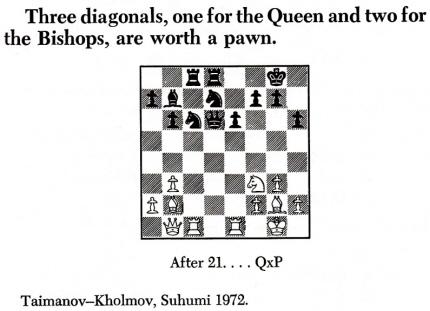
Source: Maxims of Chess by John W. Collins (New York, 1978), page 57.
8736. ‘A glorious scramble’
From Brian Harley’s column in the Observer, 19 September 1937, page 27:
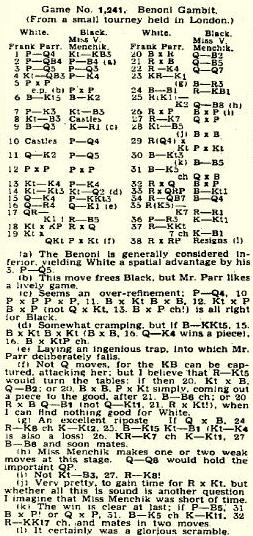
Frank Parr – Vera Menchik
London, 1937
Benoni Defence
1 d4 Nf6 2 c4 c5 3 d5 d6 4 Nc3 e5 5 dxe6 fxe6 6 Bg5 Be7 7 e3 Nc6 8 Nf3 O-O 9 Bd3 Kh8 10 O-O d5 11 Qe2 d4 12 exd4 cxd4 13 Ne4 e5 14 Ng3 Nd7 15 Qe4 g6 16 Qh4 Qe8 17 Rae1 Rf4
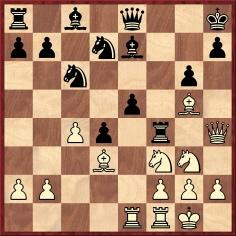
18 Nxe5 Rxh4 19 Nxc6 bxc6 20 Bxh4 Qf7 21 Rxe7 Qf4 22 Re4 Qd2 23 Rfe1 Ba6 24 Bf1 Rf8 25 R1e2 Qc1 26 Rxd4 Bxc4 27 Re7 Qxb2

28 Nf5 Bxf1 29 Rdxd7 gxf5 30 Bg3 Bc4 31 Be5+ Qxe5 32 Rxe5 Bxa2 33 Rxa7 Bg8 34 Rc7 Bd5 35 Ree7 Ra8 36 h3 Kg8 37 Rg7+ Kf8 38 Rxh7 Resigns.
A report on page 364 of the July 1937 BCM:
8737. Yates
Our latest feature article is The Death of F.D. Yates.
8738. Rules of thumb
Further to various earlier comments (see Chess: the Need for Sources and C.N. 3525) about Chess Rules of Thumb by Lev Alburt and Al Lawrence (New York, 2003), four other entries are shown here.
Page 64:

As mentioned in C.N. 8718, no firm connection has been established with Tarrasch (who has also been described as a nineteenth-century figure by Cathy Forbes; see page 268 of Kings, Commoners and Knaves).
Page 103:

‘Rudolf’ Teichmann is unknown in the chess world. The quote itself has yet to be authenticated. It was discussed in C.N. 2307 and 2339 (see pages 342-343 of A Chess Omnibus), and the former item quoted the earliest sighting that we could find (a second-hand version published five years after Teichmann’s death):
‘Zu meinem Trost hat der grosse Meister und Lehrer Teichmann mir vor Jahren in Zürich auseinandergesetzt (wobei er leicht übertrieb): “Das Schach besteht zu 99% aus Taktik”.’
Source: page 134 of volume 4 of Schachtaktik by Erwin Voellmy (Basle, 1930).
As regards an English-language version, the following was on page 97 of Chess Marches On! by Reuben Fine (New York, 1945):
‘Thirty years ago Teichmann said that chess is 99% tactics.’
Page 105:

The advice attributed to Lasker is many, many centuries older, as shown in C.N.s 7837 and 7841. Nor should Lasker’s name appear in connection with the well-known photograph, which was the frontispiece to Der Schachwettkampf Schlechter-Tarrasch (Leipzig, 1912):

Page 136:
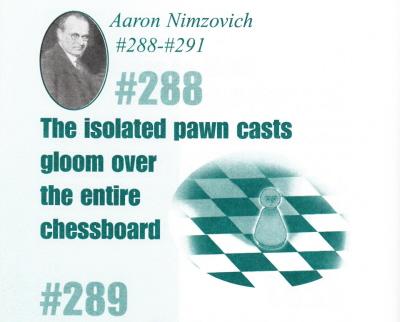
This famous remark was by Tartakower. See C.N.s 4329 and 5120.
8739. William Winter on Edward Tinsley
C.N. 8725 referred to William Winter’s criticisms of Edward Tinsley (1869-1937). The relevant pages of CHESS are given below:
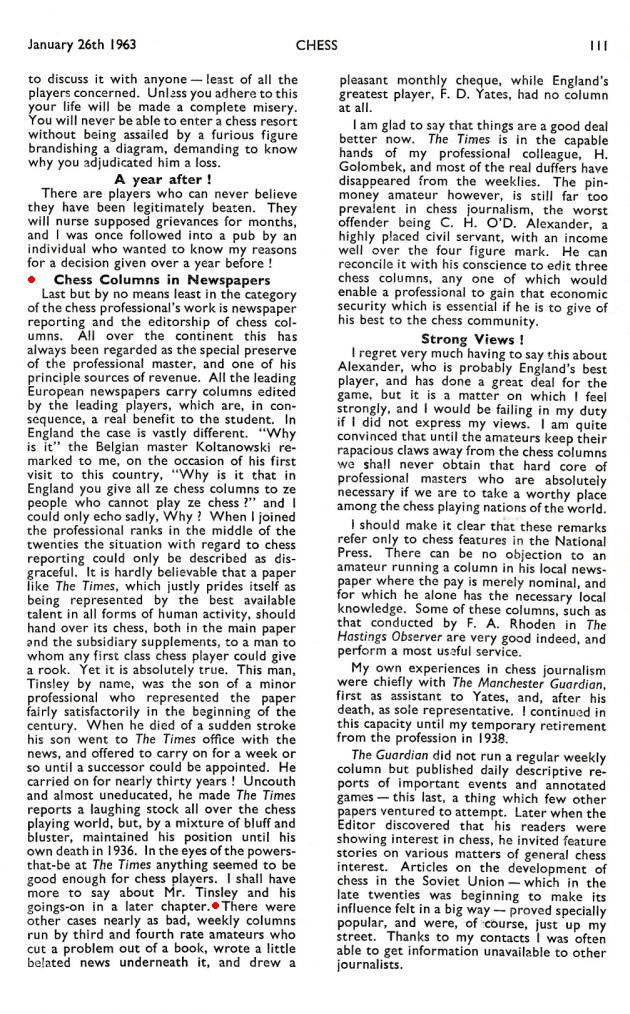
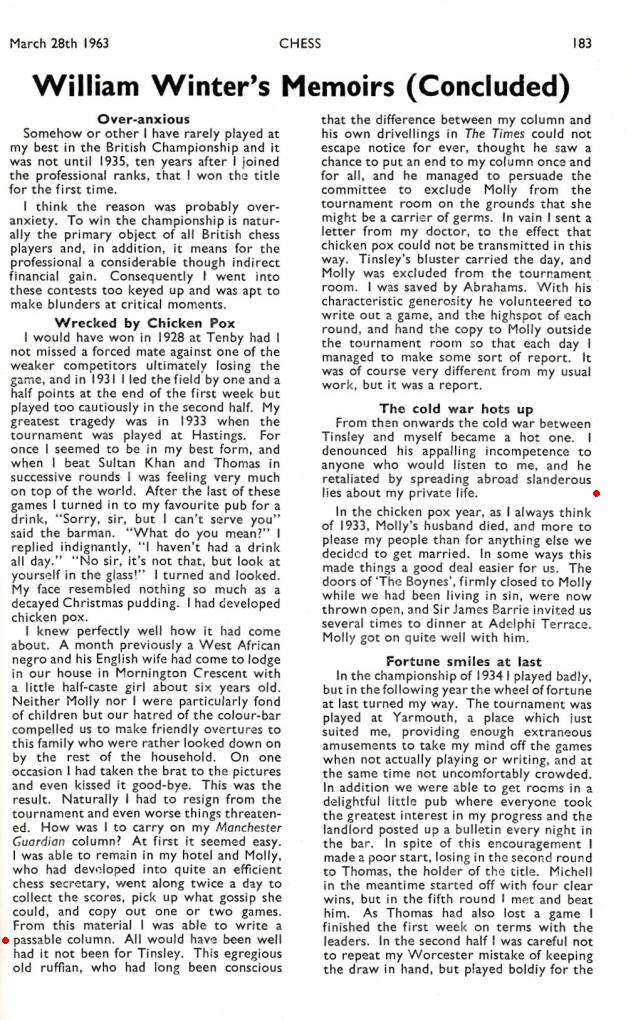
8740. William Winter and Sir James Barrie (C.N. 8739)
From Olimpiu G. Urcan (Singapore):
‘In the extract from his memoirs in CHESS which was shown in C.N. 8739, William Winter mentioned his uncle, Sir James Barrie (1860-1937), the Scottish writer who created Peter Pan. In mid-1937 Winter received news coverage, and particularly in the provincial press rather than in national newspapers, for two separate matters concerning family finances.
Firstly, in late June 1937, a few days after Sir James Barrie’s death, Winter accused Terence Jenette of extortion.’
Mr Urcan has provided these cuttings:
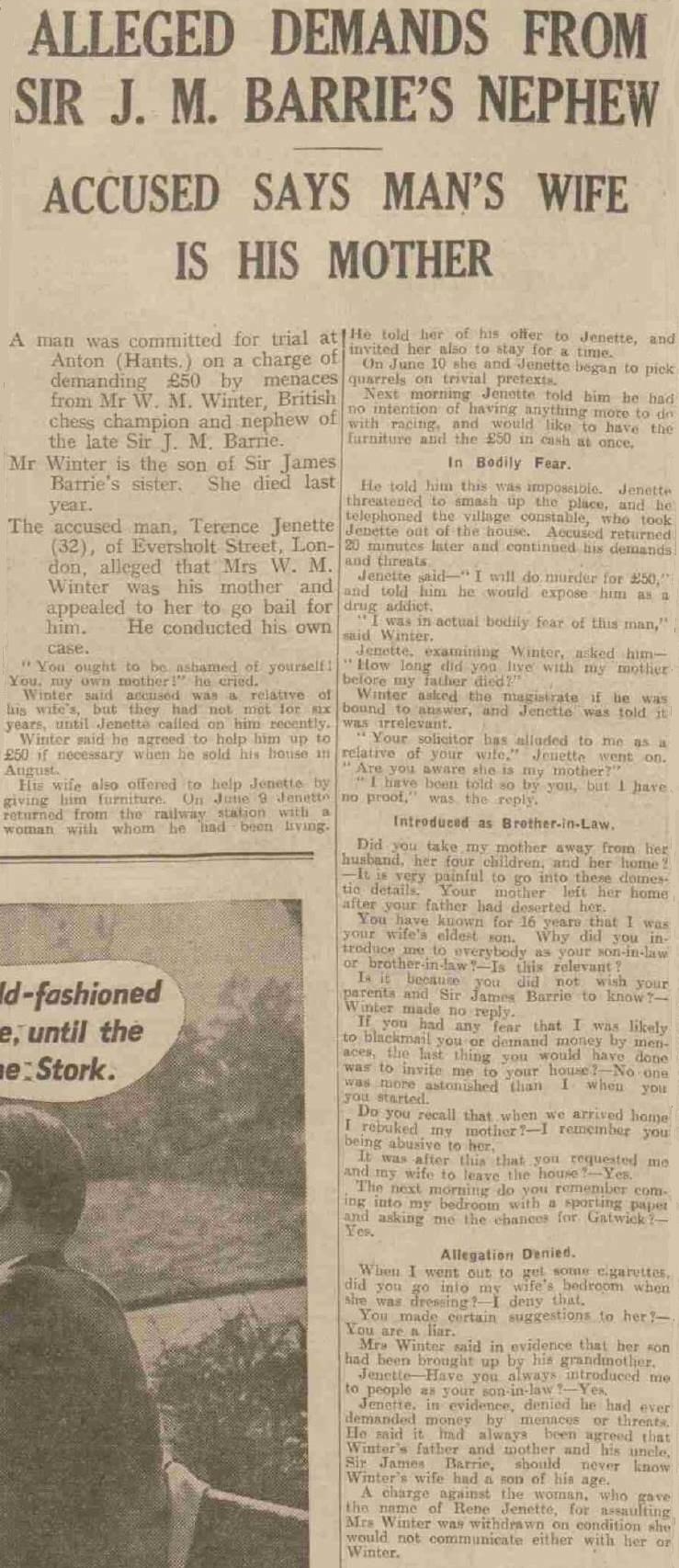
Evening Telegraph (Angus, Scotland), 24 June 1937, page 6
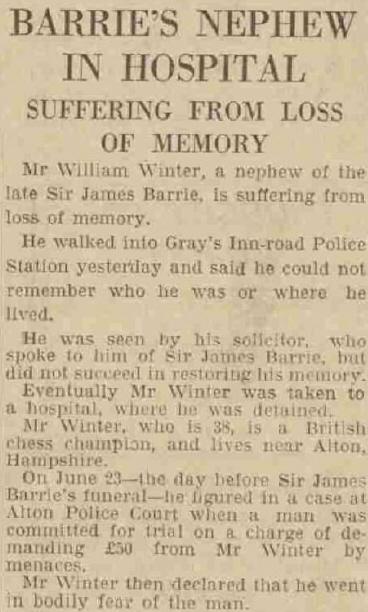
Hull Daily Mail, 1 July 1937, page 7

Evening Telegraph (Angus, Scotland), 1 July 1937, page 4

Nottingham Evening
Post, 16 July 1937, page 9. (The board position is
from Winter v Thomas, Nottingham, 1936)
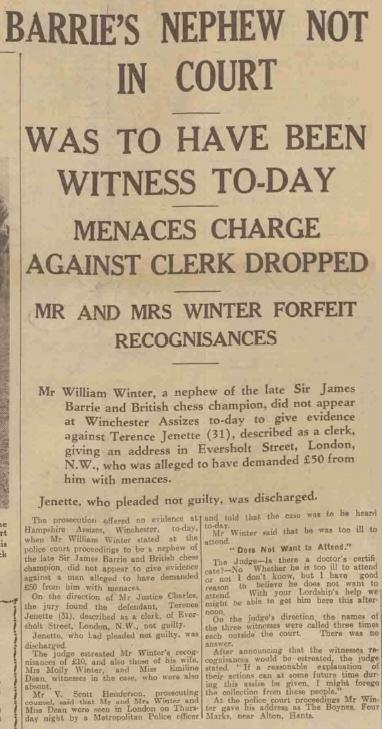
Evening Telegraph (Angus, Scotland), 16 July 1937, page 1
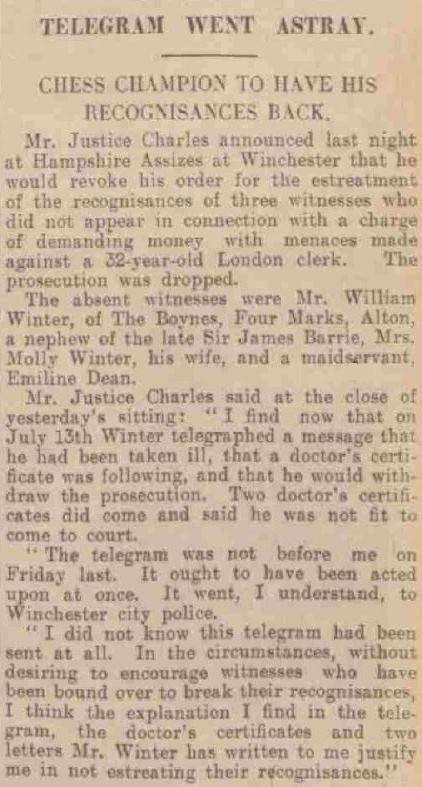
Nottingham Evening Post, 21 July 1937, page 3
Mr Urcan also supplies newspaper reports concerning William Winter’s unsuccessful attempt to dispute Sir James Barrie’s will by filing a caveat:
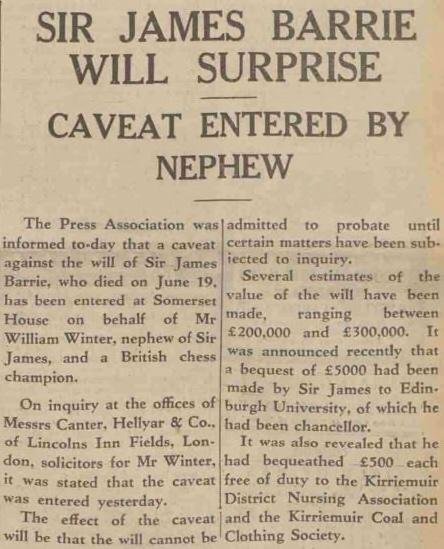
Evening Telegraph (Angus, Scotland), 24 July 1937, page 3

Dundee Courier, 26 July 1937, page 8
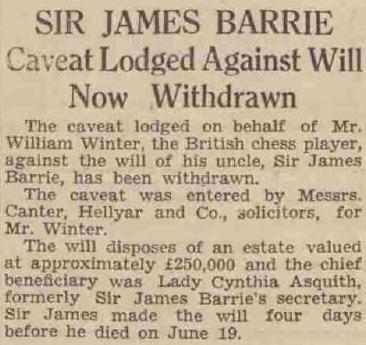
Gloucestershire Echo, 16 August 1937, page 1
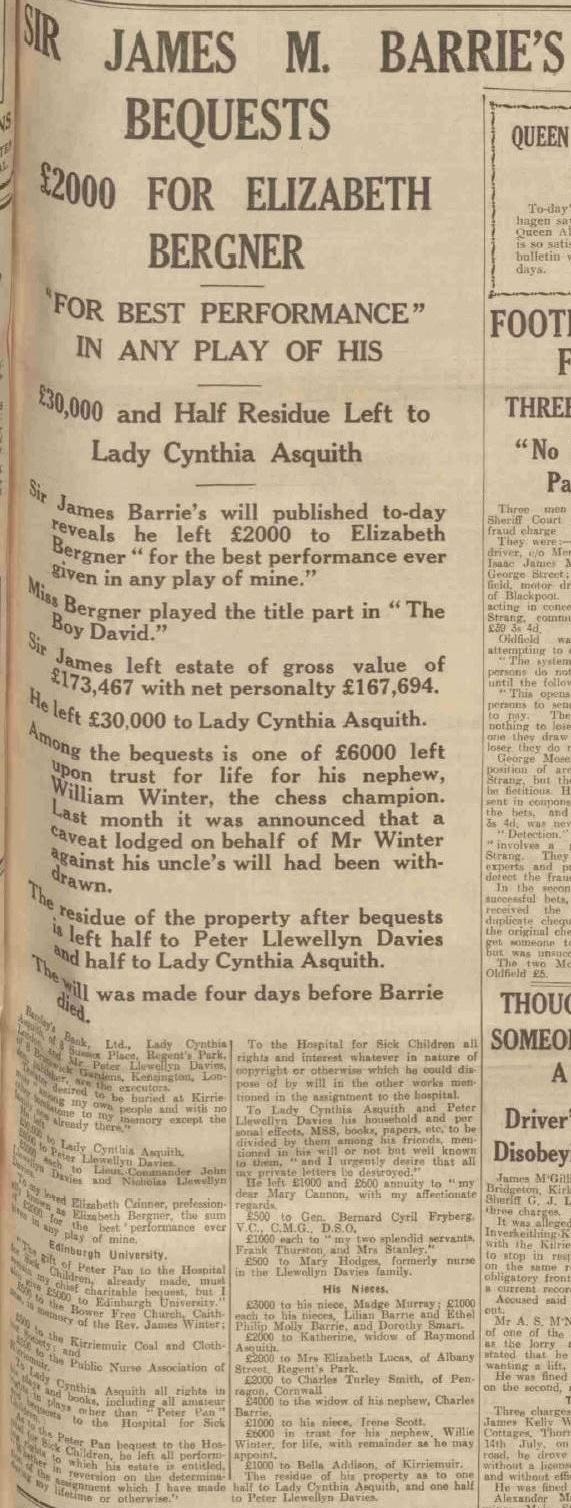
Evening Telegraph (Angus, Scotland), 17 September 1937, page 1.
8741. London,
1937 (C.N. 8736)
Chess literature seems to offer almost no information about the London, 1937 tournament mentioned in C.N. 8736. Below is a reference to it by Harry Golombek in his Times column, Review section, 29 September 1973, page 11:

8742. High praise from Lasker
As mentioned in C.N. 2663, in the 1930s Emanuel Lasker offered high praise to a new chess book. For instance:
‘In the case of the difficult science of the openings on which attention has been focussed for decades ... any master, even a world champion, might be proud of such an achievement as this. Neither Euwe nor Alekhine nor Capablanca nor I can boast of such a splendid achievement in this sphere. There is one man in the USSR who would be equal to this task, and that is Botvinnik, but the time has not yet come for him to share his thoughts with the world.’
The author of the book in question is the subject of our newest feature article.
8743. Year of birth
William Winter’s ‘established’ date of birth is 11 September 1898, but a number of old sources gave the year as 1899. These include his obituary on page 11 of The Times, 19 December 1955, which relied heavily on the biographical feature on page 53 of the 1936 edition of Chess Pie.
The year 1899 was also on page 19 of The Anglo-Soviet Radio Chess Match by E. Klein and W. Winter (London, 1947):

A footnote on page 14 mentioned that the chapter in question, ‘Biographies of the Players’, had been written by Klein.
From page 67:

Additions continue to be made to our feature article on William Winter.
8744. London, 1937 (C.N.s 8736 & 8741)
No corroboration has yet been found of Harry Golombek’s description of London, 1937 as a ‘selection tournament’ for one place on the British Chess Federation’s team at the Olympiad in Stockholm. We do not know whether administrative archives have survived, but the selection process was publicly reported in 1937 as follows:
From page 254 of the May 1937 BCM:
‘The Executive Committee of the British Chess Federation met at the City of London Chess Club on 10 April, and it was decided to send a team of five players to take part in the Team Tournament at Stockholm, and also to nominate two women competitors for the world’s championship. The selection committee consists of H.E. Atkins, R.C. Griffith, A.J. Mackenzie, R.P. Michell, and L.P. Rees was nominated with instructions to approach each unit of the BCF to furnish names of those whom [sic] it is desired should get a place.’
Page 362 of the July 1937 issue recorded that the team selected was C.H.O’D. Alexander, H. Golombek, P.S. Milner-Barry, Sir George Thomas and W. Winter. The following month (page 416) the BCM stated:
‘The indisposition which prevented W. Winter from entering for the BCF championship at Blackpool will also prevent his taking his place in the English team at Stockholm. Unfortunately, T.H. Tylor was unable to go. G.S.A. Wheatcroft will be the fifth representative and we are sure will do well. Sir G.A. Thomas is acting captain. It is never safe to prophesy but we anticipate the English team will be well to the fore.’
From page 352 of CHESS, 14 June 1937:
‘The British team at Stockholm will be Messrs. C.H.O’D. Alexander, H. Golombek, P.S. Milner-Barry, Sir G.A. Thomas and W. Winter. Once again the Federation has been rather alarmingly business-like in choosing the team before the British championship is played off. Last year Sir George Thomas, one of the selections for the Nottingham masters’ tournament, finished eighth at Bournemouth behind six young players not selected. It is up to the younger generation to protest at Blackpool in the most effective way possible, by seizing the top places in the table.’
Page 453 of the 14 August 1937 issue of CHESS reported:
‘W. Winter, ex-British champion, dropped out of both the British championship and the British team at Stockholm on account of ill-health. G.S.A. Wheatcroft took his place in the latter.’
This change was also mentioned, without further particulars, by Brian Harley in his chess column on page 17 of the Observer, 8 August 1937.
8745. Buenos Aires, 1939
William Winter was included in the Scottish team due to play in the 1939 Olympiad, although Scotland eventually decided not to participate. This news item was on page 239 of the April 1939 CHESS:
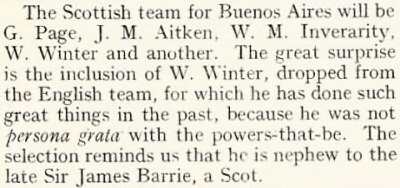
8746. Meek v Milner-Barry
From page 351 of the 14 June 1937 CHESS:
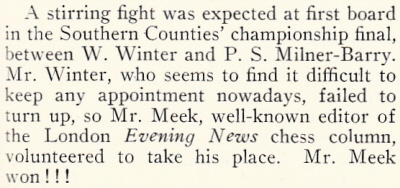
Page 316 of the June 1937 BCM reported that Meek (Middlesex) defeated Milner-Barry (Cambridgeshire) on board one in a Southern Counties Championship match on 9 May. Meek ‘was acting as deputy for W. Winter, who failed to appear’.
Can the moves of Meek’s victory be found?
8747. ‘Bernstein v Capablanca’
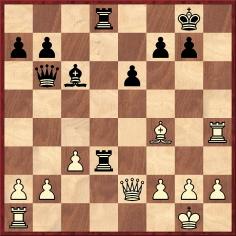
Black to move
The above position was given in William Winter’s Chess for Match Players, i.e. on pages 231-232 of the original 1936 edition and, as shown below, on page 232 of the revised 1951 work:
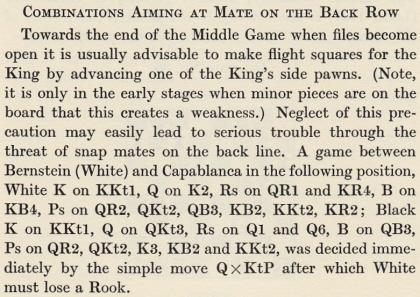
There is an obvious resemblance to the conclusion of Capablanca’s famous victory over Bernstein in Moscow, 1914 (given in My Chess Career), but what is the origin of this version?
8748. William Winter and Sir James Barrie (C.N. 8740)
William D. Rubinstein (Melbourne, Australia) notes that the sum left by Sir James Barrie, £173,467, corresponds to approximately £11,000,000 today. He asks whether other notable chessplayers have been related to eminent figures in a field other than chess.
8749. In a fog
‘A player in a fog as to the movements of two or three pieces – what will he do with two-and-thirty?’
Source: The Art of Chess by James Mason (London, 1898), page vii.
From page ix:
‘We should, first of all, be intent upon the end at which we would arrive, if we would best avail ourselves of the means of getting there. Thus, in chess, it is the end we should consider first, so as to more easily master the simple ideas of the game, that we may become readily familiar with them, in order to go on with confidence to their combination or involution. Again, if you do not know what to do with three pieces, what about thirty-two?’
And from page xi:
‘Of all parts of the game, the opening, say, the first dozen moves or so, is ever the least understood, even by the accomplished player, and it is just this part that the neophyte is usually recommended to master at the beginning. A more fatuous gripping of the wrong end of the stick it would be hard to imagine. It is as if the cadet were to devote himself to the mastery of the higher tactics or strategy of a grand army in the field, while yet innocent of company drill, or of the formations and evolutions of a single battalion.’
The second edition of Mason’s book has been quoted. The chapter in question, ‘Method’, is absent from the original edition (London, 1895).
8750. Pomar on Alekhine
Shortly after Alekhine’s death, Arturo Pomar published a tribute which included some comments on his personal contact with the late world champion:
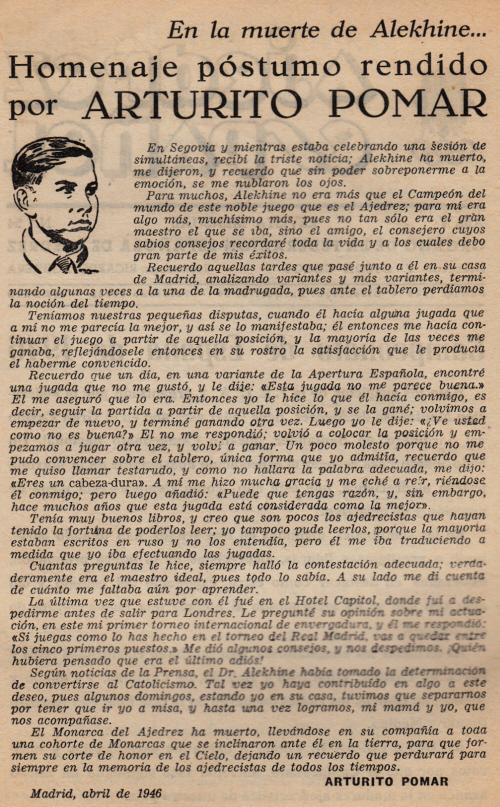
Source: Ajedrez Español, June 1946, page 178.
8751. Misplaced knight (C.N. 8718)
From the chapter about the knight on page 69 of Maxims of Chess by John W. Collins (New York, 1978):
‘Badly placed, it is a definite weakness and prompts the old sayings: “A knight on the side brings only trouble” or “A knight on the rim is dim.”.’
‘A knight on the side brings only trouble’ was the wording on page 21 of Modern Chess Strategy by Ludĕk Pachman (London, 1963), being a translation by Alan S. Russell from the German edition, which had the ‘Springer am Rande’ wording (C.N. 8718). The phrase had also been given in German on page 81 of Pachman’s original book in Czech, Strategie Moderního Šachu (Prague, 1957).
A photograph of Frederick Wolff Ogilvie (1893-1949) on page 359 of CHESS, 20 June 1939:

8752. The Wallace murder case
‘The Wallace case remains the greatest of all unsolved crime puzzles. Either William Herbert Wallace devised the perfect crime with the skill of a practised chess-player, or else the real murderer planned it with diabolical cunning and nearly sent the mild insurance agent to the scaffold.’
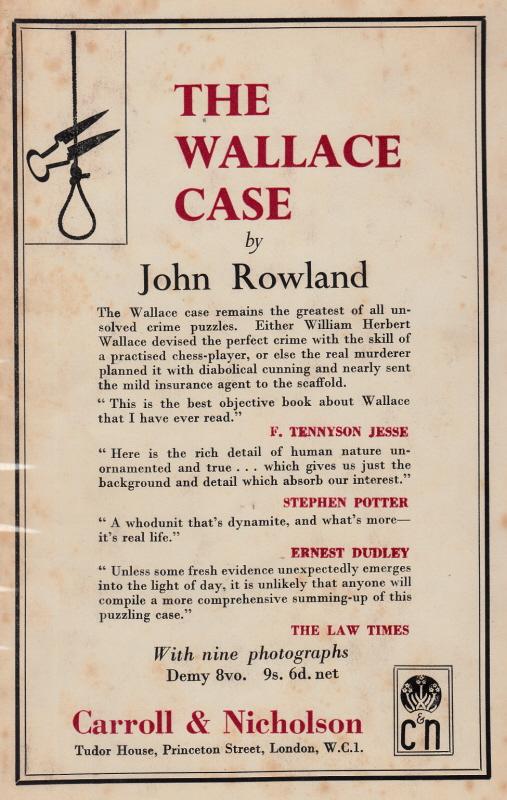
This advertisement was on the back of the dust-jacket of the 1951 edition of William Winter’s Chess for Match Players, which was brought out by the same publisher.
8753. Alistair Cooke
The Wallace murder case was mentioned by Alistair Cooke at the start of an article, ‘The Hiss Case Reviewed’, on pages 6-7 of the Manchester Guardian, 1 May 1953:
‘Whenever the late James Agate was satiated with the theatre and bored with books and racehorses, he would call up a couple of lawyer friends and invite them to hash over for the hundredth time the events of that one evening in the life of Wallace, the Liverpool chessplayer, which, it can be cogently argued, produced either the perfect crime or the perfect miscarriage of justice.’
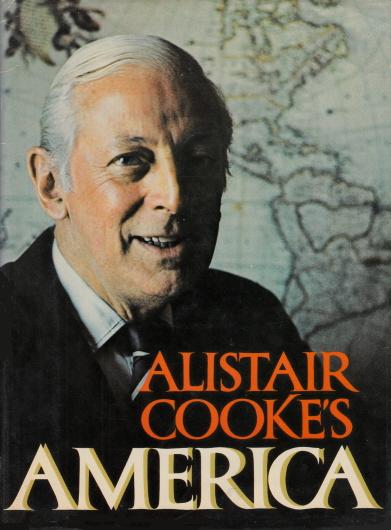
A new feature article has just been posted: Alistair Cooke and Chess.
8754. About to resign
Games by the problemist Murray Marble are scarce. A snippet from page 88 of the Literary Digest, 19 January 1901:
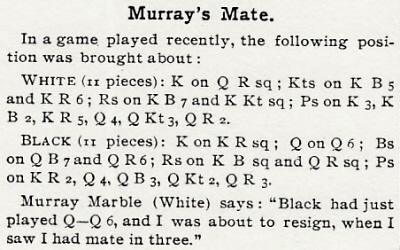
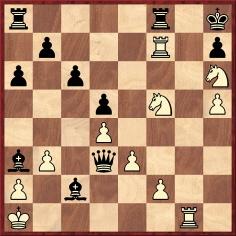
Position after ...Qd3. White mates in three
8755. Endgame study

White to move and win
This composition will be discussed in a forthcoming item.
| First column | << previous | Archives [120] | next >> | Current column |
Copyright: Edward Winter. All rights reserved.